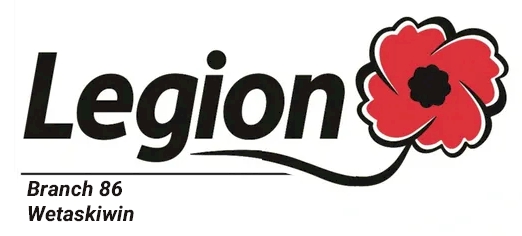War Duty - Convoy Escort in the Battle of the Atlantic - 1940-1946
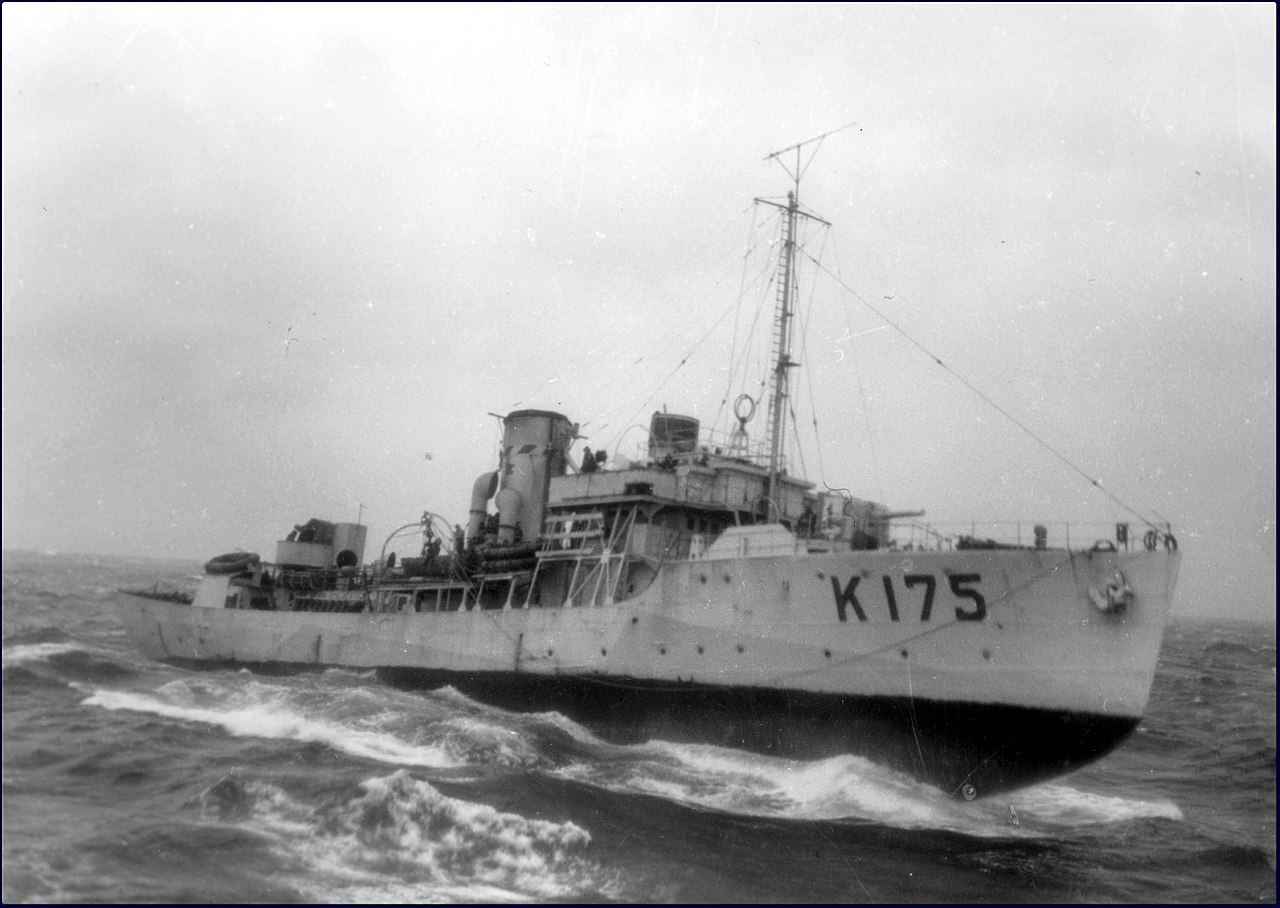
Pendant #175
6 Officers and 79 Crew
201.1 ft
950 tonnes
Canadian Service 1940-1946

6 Officers and 79 Crew
201.1 ft
950 tonnes
Canadian Service 1940-1946
HMCS Wetaskiwin (Pendant Number K175) was a Flower Class corvette serving with
the Royal Canadian Navy (RCN), as a convoy
escort in the Battle of the Atlantic during World War II. She served most of her deployment in the unforgiving North Atlantic Ocean where Kriegsmarine's U-Boats patrolled the shipping lanes to attack shipping convoys in order to cripple vital supply lines of food, oil, equipment, supplies and raw
materials for Britain, Occupied Europe and the Soviet Union. Millions of lives were at stake and the corvette was a near-perfect anti-U boat weapon.
HMCS Wetaskiwin was one of 122 Flower Class corvettes built in Canada.
While not as prominent as larger warships, HMCS Wetaskiwin and other Canadian-built Flower Class corvettes became the mainstay of Allied convoy protection. They escorted thousands of ships from the Aleutians to the Caribbean and Mediterranean, from the East Coast of North America to the Artic, Iceland and Northern Ireland. They hunted submarines and engaged in combat. Along the way they rescued hundreds of survivors from ships that had been torpedoed. Corvettes became the an obvious presence in a convoy, safeguarding the lives of thousands military personnel, civilians, valuable ships as well as cargoes.
First Sea Lord Admiral Sir Dudley Pound, is quoted as saying, The Canadian corvettes solved the
problem of the Atlantic convoys.
This statement is singularly noteworthy considering that in 1939, Canada had a fledgling navy.
The Royal Canadian Navy personnel numbered less than 2,ooo and it possessed six destroyers, five small minesweepers, two training vessels left over from the First World War and about three dozen ocean-going Canadian-registered merchant ships. Canada's convoy escort duties commenced at the outbreak of war. By early 1940 Canadian destroyers were engaged in battle in European waters. Still, no
one would have predicted that, from this tiny beginning,
97,600 men and 7,100 women would signed
up for the navy and over 330 warships would be commissioned. By 1945, the Royal Canadian Navy had the third largest allied fleet in the world.
Canada and Newfoundland's participation in World War Two was virtually unquestioned. Men and
women rushed to enlist and were a major factor in the Allied victory.
Due to the urgency of war, Canada's navy recruits received rudimentary training before being assigned a position on a battle ship. To serve aboard a corvette like the Wetaskiwin required unflinching courage and tenacity. It was at sea that raw recruits turned into real sailors and acquired the technical proficiency to do their job and the discipline to live at sea in cramped adverse conditions. Along the way they found the spirit and determination to persevere. No matter their age, the courageous men and women who served steered the RCN through some of the Second World War's toughest times and in combat played a vital role for the duration of the war, leaving the Royal Canadian Navy with a distinguished legacy.
The journey of HMCS Wetaskiwin, its early maneuvers, war missions, battles, along with the naval experiences of its crew in the Atlantic war against Kreigmarine submarines was not glamorous and made no compelling history. It is, however, deeply
intertwined with the challenges, sacrifices, achievements and legacy of the long-drawn-out Battle of the Atlantic. This warship's chronicle gives an accounting of those events and mirrors the story of the men and women who served to make an Allied victory possible.
It is an enduring story that has its niche in Branch 86 of the Royal Canadian Legion. It is not just for history buffs. HMCS Wetaskiwin's legacy is one of bravery, resilience, and community spirit.


by "Sanko"
You can choose to read some background information about WWII that triggered the launching of HMCS Wetaskiwin K175 by simply expanding a heading below. Alternatively, you can scroll to the next section to begin reading this warship's story.
On September 23, 1939, eight hours after Britain and France declared war on the German Reich, the Kriegsmarine struck hard. German submarine U-30 patrolling the Western Approaches off the coast of Ireland torpedoed the SS Athenia, a British passenger ship working between Canada and he United Kingdom, killing 117 passengers and crew. Three-quarters of her passengers were women and children. Among those that lost their lives - 54 were Canadian and 28 were US citizens)*.
The Battle of the Atlantic had begun, and from that evening to the dusky hours of Monday, May 7, 1945, it never ceased.
One gets the the impression of one major battle, relentless clashing. It actually was a series of ferocious, grinding campaigns waged sporadically across the Atlantic Ocean and touching three continents (North America, Europe, and Africa) as Allied navy commands struggled to protect trans-Atlantic shipping from German submaries that terrorized convoys, crippled crucial supply lines between North Americ and Europe, making it the longest, largest, most arduous and complex naval battle in history.
The Battle of Britain lasted 68 months. There was significant cost in the number of ships sunk until the Allies gradually gained the upper hand. Victory was costly. More than 70,000 allied seamen, merchant mariners and airmen lost their lives at sea and have no known grave.
For the whole of the World War II the Royal Canadian Navy (RCN), merchant navy and air force were engaged in the Battle of the Atlantic (1939-1945) with the RCN playing a crucial role against the sea and air attacks perpetrated by German Reich.
* Whether the sinking of the Athenia was deliberate or the U-boat captain mistakened the liner for an armed cruiser, the attack on an unarmed passenger liner was a clear breach of international protocols. Conspiracy theories circulated. However, the mere presence of a U-boat off the coast of Ireland was was a clear indication of Hitler's maritime intentions.
**In 1917, a German submarine torpedoed and sank the first SS Athenia, also just off the coast of Inishtrahull, Ireland. Rockall Bank, an area of raised seabed a few hundred km from the Irish coastline.
In the spring of 1940, the war in
Europe took an ominous turn. After the fall of France on 17 July 1940, Britain and her Commonwealth Allies were left to defend against the Axis (German Reich and Italy) taking the whole of Europe. With its isolation from Europe and its lifeline to European imports completed cut off, Britain was more dependent upon goods shipped from North America. The
British required more than a million tons of food, oil, equipment, supplies and raw
materials to be shipped in each week.
Allied Response and Early Convoy Strategies
German Reich's Perspective
From the German Reich's perspective, an Axis blitz on allied shipping would choke off vital supplies and force Britain into surrendering. With France and the low countries defeated, Germany had control of the entire coast of Europe which gave their Kriegsmarine (German Navy) direct access to the Atlantic.
The Kriegsmarine (German Navy) went on the offensive using a range of warships, U-boats, auxiliary cruisers and long-range aircraft. Their navy and airforce set out
from every harbour and airfield in western Europe to sever the lifelines to
Britain. They bombed British shipping ports and deployed surface raiders, warships, merchant raiders, U-boats and aircraft to patrol critical supply routes, especially in the Western Approaches. Submarines lurked in the Black Pit.
One German battleship, the Admiral Graf Spee alone, sank nine merchant
ships totaling 50,000 tons between September 30 and December 7 of 1939. Their surface raiders caused havoc and long-range Focke-Wulf Condor
200 bombers sank 580,000 tons of British shipping the following
year (1940). U-boats, their deadliest ocean predators, lurked beneath the
Atlantic ocean hunting for merchant vessels.
Merchant Ships Easy Prey
Prior to the war, merchant ships crossed the Atlantic singularly or in pairs between Halifax and New York to ports in England or Northern Ireland. The only protection available against a merchant raider might be an armed yacht. Merchant vessels were heavily loaded, low, slow in the water and vulnerable. These ships were easy prey and faced constant threat from warships and submarines.
Establishing and protecting shipping lanes
did not only depend on the success of the Armed Forces but also a massive
personal risk to the civilians sailing under an Allied flag. Remembering that in World War I German
submarines had brought their country to within three weeks of starvation, the British Admiralty wasted no time in organizing a convoy system to protect merchant ships.
Canada immediately responded.
The Royal Canadian Navy only had eleven combat vessels at the time. It rushed four destroyers to the British Isles to protect convoys on its western shores and used its other vessels to protect the convoys on this side of the Atlantic.
Canada Created Merchant Navy
When war was declared, the Canadian government immediately moved to pass laws to create the Canadian Merchant Navy to provide a workforce for wartime
shipping. Facing high casualties rates and showing undeniable courage, 12,000 men and women, aged from fourteen through to their late seventies, rushed to enlist in Canada's Merchant Navy. The Merchant Navy was considered a fourth
branch of the Canadian military alongside the Royal Canadian Navy, Canadian Army, and the Royal Canadian Air Force, and suffered the
highest casualty rate of the four. Rear Admiral Leonard W. Murray reported: The Battle of the Atlantic was not won by
any Navy or any Air Force, it was won by the courage, fortitude and
determination of the British and Allied Merchant Navy.
Early Convoy Strategies in WWII
The British Admiralty requisitioned anti-submarine escort groups to protect the convoys in the Western Approaches and convey ships to a zone in the mid-Atlantic beyond enemy U-boat range. British defence resources being spread thin, the Royal Navy had a critical shortage of escort vessels. They pulled together destroyers and old generation naval vessels. They militarized yachts, passenger liners, survey ships and fishing trawlers - any vessel that was sufficiently seaworthy.
Since most of these vessels did not have the range or endurance to accompany convoys through the mid-Atlantic, the Royal Navy utilized a relay system where one escort group protected a convoy to a designated meeting point and handed protection over to another escort group to accompany the convoy from England to Ireland and across the Western Reaches. However, routing of trans-Atlantic convoys required meeting points beyond the range of anti-submarine sea vessels
The convoy had some protection from the air. An aircraft could cover a larger area than any warship and could
pounce on an unsuspecting submarine with deadly effect before it could dive out of harm's way. However, the British Admiralty and Allied Coastal Command was perpetually short of aircraft for trade defense, because the mainland bomber offensive was prioritized. The aircraft allotted to convoy protection were effective in limiting the places U-boats could attack a shipping convoy, but lacked the fuel range to provide air cover through the central part of the Atlantic Ocean.
Between ports near naval bases, such as at Halifax, Gaspe or Quebec City in Canada or between Liverpool, Portmouth, or Londonderry in the United Kingdom escorting a convoy was less complicated. However, efficient routing of trans-Atlantic convoys required meeting points beyond the range of anti-submarine sea and air escorts on both sides of the ocean.
For the whole of the World War II Canada's Royal Canadian Navy, Royal Canadian Air Force (RCAF) and Canadian Merchant Navy were engaged in the Battle of the Atlantic (1939-1945). The RCN playing a crucial role against the sea and air attacks perpetrated by German Reich.
There was a dangerous zone in the mid Atlantic that no plane from Canada, Ireland, Iceland, or Britain could reach. It was a zone about 300 kilometers wide called the Mid-Atlantic Gap where convoys steamed for four to five days without land-based anti-submarine air escort before being picked up by the Allied air escort on the other side. In this undefended zone slow-moving convoys were vulnerable.
Toward the end of 1940, Kriegsmarine, Germany's U-boat command, was able to exploit this weakness because their submarines were able to extend their range of operations beyond the Western Approaches and further into the mid-Atlantic than the previous months of the war. In pursuit of destroying vital convoys that were Britain's lifeline, U-boats steadily patrolled this undefended zone. It was excellent hunting ground.
To the 4,000 ships convoyed across the Atlantic in 1940, this zone of the Atlantic without air support was dangerous. Sailors dubbed it The Black Pit because that was where U-boats inflicted the most damage.
The Allies were in dire straights. The
Enigma Code had not yet been cracked, no fixed ground radar station had yet been established for aircraft, breakthroughs in sonar, radar for ships, HF/DF (radio-goniometry) were months from being highly functional, anti-submarine escorts lacked the
endurance to accompany convoys through the mid-Atlantic. While the convoy system limited losses, Great Britain and her allies had a lack of escort ships.
Meanwhile, Hitler’s U-Boats were terrorizing the shipping routes. German U-boats were superior weapons due to excellent technology and a highly skilled, well-trained crews. U-boats sank 199 merchantmen and a third of the Royal Navy’s battleship strength in the first months of the war. By the end of 1940, U-boats had sunk almost 2 million tons of Allied shipping in the Battle of the Atlantic. Shipping losses were staggering and the loss of life among merchant seamen and allied sailors was tragic.
Merchant ships were being sunk faster than they could be
replaced. Whereas, the German Reich launched eight U-boats for every one they lost and had the capability to deploy a small but steady stream of warships to the Atlantic.
Kriegsmarine command had the advantage of its enigma machine for communication and it also implemented wolf-pack hunting tactics. Roving packs of submarines spaced at a distance from each other patrolled for convoys. Once a convoy was spotted the U-boats in groups of 6-20, moved in closer and waited patiently at a distance for darkness, when they were virtually
undetectable. U-boats torpedoed unprotected convoys indiscriminately and with impunity.
The U-boats picked off solo ships and
stragglers and made bold, single-handed attacks on convoys. These young aces,
the German elite, raced each other for tonnage sunk. German naval commanders later referred to the period July to September 1940 as "the happy time."
~ Veterans Affairs Canada
After a major defeat in October 1940 when a critical convoy from Halifax to Liverpool was attacked by five U-boats - twenty of thirty-five cargo vessels were sunk there was imminent danger that deprived of food and oil millions of people would perish and Great Britain would fall without a single Axis soldier stepping foot on their island.
The German Reich had the upper hand. While a far greater threat to ships at sea, which put the supply link between North America and
Europe at even greater risk, there was cause to fear that U-boats would eventually launch attacks on land-based facilities or harbours in Eastern Canada or Newfoundland.
Before the start of World War II, Britain's Royal Navy was deemed the strongest navy in the world with naval bases in all corners of the globe and the fact that they had built the largest number of warships and had as many ASDIC warships in service as all the other navies of the world combined. It was a navy prepared to jolt into action.
Due to the pace of global events the expansion of the German Reich threatened the lives of millions of people United Kingdom, Occupied Europe and the Soviet Union. There was an urgent need for patrol and escort vessels to protect the Atand lantic shipping convoys which were transporting vital supplies - food, oil, equipment, supplies and raw
materials. German U-boats were sinking 1,000 tons of Allied shipping every hour.
Warfare is a large and urgent enterprise. Naval engagements between the Allies and German Reich were usually of short duration; but warships such as destroyers, frigates and submarines are not put into action quickly. They are the product of a years of functioning organization, time consuming preparation, scientists and engineers frantically working, financing and resource procurement before construction even begins. Then of course there is the recruitment and training of manpower. In other words, even a rushed naval programme might not materialize within two to three years.
To meet its urgent need for patrol and escort vessels, Britain devised a plan to boost naval defence using Flower Class Corvette's. Shipbuilding yards in the United Kingdom were at capacity. Canada’s small-yet-professional navy sought to expand its fleet
quickly. By early 1940, the Royal Canadian Navy had Canada's ship building program underway.
Beyond building the ships, Canada played a major in the Battle of the Atlantic and the rise of the Royal Canadian Navy was due to Canada building Flower-Class Corvettes.
At any one time there could be a dozen
convoys (up to 20,000 people aboard) crossing the Atlantic at the same
time.
All convoys were classified according to speed and destination. Convoys designated as HX were British bound convoys carrying explosive cargo (oil, munitions) expected to sail from Halifax to England in 15 days.
A slow convoy was the worst assignment. It was more vulnerable to attack than fast moving convoys. Merchant vessels were older, weather-beaten, and prone to breakdown. Slow convoys were routed north toward Iceland which was a longer rougher passage by about another 5-6 days. Moreover air support from Iceland was limited.
H (Homebound) - convoys bound for Britain
O (Outbound) - convoys returning to Halifax or Sydney
HX - fast homebound convoy carrying explosive cargo (oil, munitions)
sailing from Halifax or New York - typically made the crossing to from
Halifax to England in 15 days.
SC - slow convoys, regardless of destination sailing from Sydney, Halifax or
New York, their common speed 7 knots. From Halifax to Liverpool took about 20
days.
ON: westbound convoys sailing from Great Britain to North America
JM - convoys from British ports to Murmansk
PQ - convoys from Nova Scotia via Iceland to Murmansk
M - convoys sailing to the Mediterranean


HMSC Wetaskiwin had Distinctive Design for a Warship Whaler Designed for Coastal Patrol
Warfare is a large and urgent enterprise. Re-inventing the wheel was time-consuming. Large cruisers and destroyers were complex and expensive to produce. The Allies did not have time. Naval strategists devised a plan to boost naval defence using Flower-class corvettes, a vessel already in service with the Royal Navy and well-suited for coastal patrol.
Flower-class corvettes were not as prominent as larger warships and essentially their original design was based on a whaling ship. The British Admiralty had effectively converted the Southern Pride, a 1936 whaling ship, into a warship for inshore patrol and harbour anti-submarine defence. A whaler-type vessel was admirably
seaworthy, required less resources and was quick to build.
Given the speed and aggression of U-boats, this whaler-type vessel appeared less than an ideal warship for oceangoing convoy escort. It was lightly armed with only one gun and barely faster than merchant ships in a convoy. In rough seas, it had a tendency to pitch and roll and by warship standards it was deemed not very comfortable. Nonetheless, the Allies needed warships.
The Whaler-Type corvette was an admirably seaworthy and
maneuverable vessel, cheaper and quicker to produce than frigates. It emerged as the best solution that would meet the immediate needs of both
the British and Canadian fleets.
Shipbuilding yards in the United Kingdom were at capacity. Canada's small-yet-professional navy sought to expand its fleet
quickly, as well. The Royal Canadian Navy quickly implemented an expeditious ship-building program.
Canadian ship-builders had the facilities and expertise to build merchant ships not sophisticated warships. The Whaler Type ship's shape, a simple and stout design, was similar to that of a merchant ship which allowed the RCN to waste no time in commissioning existing shipyards in Ontario, Quebec, and British Columbia to begin production.
Canadian shipbuilders had the backbones of the first British-ordered corvettes laid down in dry dock by February 1940 and four months later they launched corvettes for both Britain and the RCN. The first Patrol Vessels - Whaler Type were laid down between February and April and launched as quickly as manpower and funds allowed. (Later they built corvettes for the United States.)
While HMCS Wetaskiwin and the other Canadian corvettes were essentially the same design as the British, the Royal Canadian Navy modified it and outfitted the ship differently to be deployed as patrol vessels for the coastal protection of convoys, and they were equipped with minesweeping equipment for harbour defence.
Launching Canadian ships posed another significant challenge for Canada. The navy needed experienced seamen and professional engineers to man the ships being launched. That required increasing navy personnel from 3000 enlisted and 3000 reservists to about 15,000 by January 1941. All the ships would be crewed with junior recruited sailors who were not accustomed to naval life, had no wartime experience, and were not trained in common anti-submarine tactics. Many new recruits who went to sea had but eight weeks of training before being assigned to a Flower-Class corvette.
The term Patrol Vessel – Whaler Type did not sound warlike to Winston Churchill who was Britain's First Lord of the Admiralty at the time. In streamlining a name, he urged the vessels be called corvettes after the French and British fast-sailing sloops of war that were in service in the mid 1800's prior to the arrival of steam driven vessels.
The corvettes were further designated as Flower-class because in Britain these warships were named after flowers: HMS Bluebell, HMS Clematis. HMS Mallow, HMS Stonecrop, HMS Candytuft, etc. Apparently the British reason for naming their ships after flowers was to mock the enemy that their wolf class U-boat had been sunk by a Tulip or a Pansy. Churchill also dubbed the corvettes cheap and nasties.
The popular, sleek luxury sports car built by Chevrolet gets its name from this agile, but conversely slow and small class of warship.
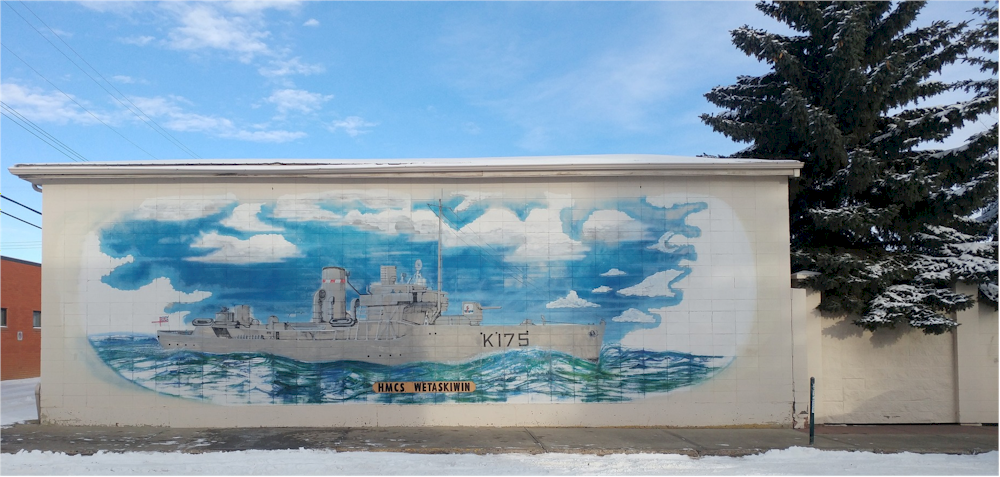
By Local Artist, Scott Nelson
HMCS Wetaskiwin K175 was the first Pacific coast built Flower-Class corvette to enter service with
the Royal Canadian Navy. She was ordered in February 1940, as HMCS Banff. Her backbone was laid on 11 April 1940 at Burrard Dry Dock Co. Ltd, Vancouver, British Columbia. She was launched just over three months later on July 18 and commissioned as HMCS Wetaskiwin at Esquimalt Naval Base, Victoria. Corvettes built at the Burrard Shipyard in Vancouver cost $605,000 each.
Acceptance trials and work ups were followed by a brief time patrolling out of Esquimalt. On 17 December 1940 the HMCS Wetaskiwin received notice of war duty and ordered to report to Halifax the following March.
Rather than follow the British naming tradition, the Canadian Naval service wanted to better represent the people and establish a bond with local communities across Canada. The first 54 ships out of the docks were named after small communities: Drumheller, Kamsack, Timmins and Wetaskiwin to name a few. In the second phase of building, Canadian corvettes were named after larger cities.
Each community sponsored their named ship and played a key role in supporting the ship and its crew. Community members wrote letters, knitted socks and sweaters; service clubs assembled clothing, food, other necessities and niceties for the men who sailed under the town’s
namesake.
However many Canadian towns and cities were involved, the Flower Class label stuck.
In the Case of HMCS Wetaskiwin, Naming of the Vessel Took a Twist and Turn
Originally corvette K175 was named Banff for Banff, Alberta. Not long after she was launched a naming conflict with the Royal Navy came to light. Through Lend-Lease the Royal Navy was acquiring ten US Coastguard Cutters that would be refitted as British battleships. These ships were being classified by the Royal Navy as Banff Class Sloops in honour of a Scottish Officer in the Royal Navy, Captain George Duff (1764-1805) from Banff, Scotland. Also, though the Royal Navy had already named a Captain-Class Frigate, the HMS Duff, after this Aberdeen captain, it was their decision to name one of the newly acquired cutters, HMS Banff.
A new name was needed and another community was selected. That is how Alberta's third oldest city, Wetaskiwin, population 2200, secured the privilege of having the corvette named HMCS Wetaskiwin.

The HMCS Wetaskiwin was one of the first Flower-class corvette warships that the RCN assigned to the Battle of the Atlantic in the spring of 1941. Initially, the vessels may not have been the ideal warship, but eventually the Allies counted on Flower-class corvettes. They proved to be a formidable presence in a convoy and formed the bastion of convoy protection.
To their advantage, the 200-foot-long Corvette, not large by warship standards, had a range of 3500 miles. Naval strategists determined that the long range and sea-going maneuverability of the corvettes made them the near-perfect anti-U boat weapon and soon ascertained just how effective the vessels could be in hunting Kriegsmarine submarines.
The corvette was a better match against U-boats than battlecruisers. Her superiority was her turning circle, the tightest of all Allied warships. In fact, the corvette could out-manoeuvre a submarine. The large reserve of steam in the vast cylindrical Scotch boilers gave
the corvette a quick burst of speed, and the vessel had a
huge rudder and fine underwater lines which made it nimble at tracking a U-boat. Most critically, despite the pitch and roll on rough seas, the corvette would not yield to the stormy weather. In the worst North Atlantic raging sea, the corvette was a workhorse that could turn on a dime.
HMCS Wetaskiwin was equipped with the Active Scanning Detection and Intercept (ASDIC) system. The rudimentary electronics were a type of sonar, efficient for detecting and tracking submarines with some precision.
The vessel's armament included one 4-inch (102-mm) Mk. IX breech-loading deck gun, a 2-pounder Mk VIII 40 mm pom-pom gun and two twin-mounted .303
Lewis machine guns.
The Mk. IX was mounted on the forecastle of the Wetaskiwin. It fired a 31-pound shell a maximum of 12,000 yards. At close range its accuracy at hitting a U-boat above surface was excellent. When a U-boat was above surface miles away with only its conning tower visible, the gun's accuracy was diminished. Though, when fired it was not always a decisive weapon against U-boats, that four-inch gun was effective in forcing the U-boat down below the surface and deep.
The pom-pom gun was mounted on a bandstand over the engine room. It was designed to counter low-flying aircraft, but it was also effective against a surfaced U-boat.
The Lewis machine guns were sited on the bridge wings, also for anti-aircraft
defense.
Wetaskiwin's most feared weapon in 1941 was depth charges. If a U-boat was within range it could be pounded by the depth charges. The depth charges were designed to detonate at a predetermined depth so as to inflict damage on a submerged U-boat. Depth charges were deployed from throwers and rails at the stern.
In 1942 the Hedgehog mortar was added. It was a was a forward-throwing weapon that fired up to 24 spigot mortars ahead of the ship. It was a form of grenade deemed much more effective than the gravity-dropped depth charges which were large, slow-sinking and could only be dropped directly astern which gave a submarine time to get out of ASDIC range. By firing Hedgehog mortars ahead and by using a smaller,
streamlined and faster-sinking projectile, the Wetaskiwin was better able to destroy a
target submarine before ASDIC contact had been lost. By British calculations, during World War II depth charge attacks were effective on a ratio of about 60.5 to 1. In comparison, the Hedgehog made 268 attacks for 47 kills, a ratio of 5.7 to 1.
As the U-boat took measures to evade the corvette's weaponry, it gave the convoy time to take evasive action and try get out of range of the enemy.
The Battle of the Atlantic turned into a small ship's war, with Flower-class corvettes making up roughly half of the escorts. They were the mainstay of a small ship anti-submarine navy.
To perform better on open seas, shipbuilders modified newly built ships to perform better, and retrofitted earlier launched vessels to lessen the pitch and roll.
Between 1941-1945, RCN Corvettes were primarily focused in the North Atlantic, from the East Coast of North America to the Artic, Iceland and Northern Ireland, but were also deployed to the Caribbean, Mediterranean, Aleutians Islands and by wars end some RCN corvettes joined the British Pacific Fleet.
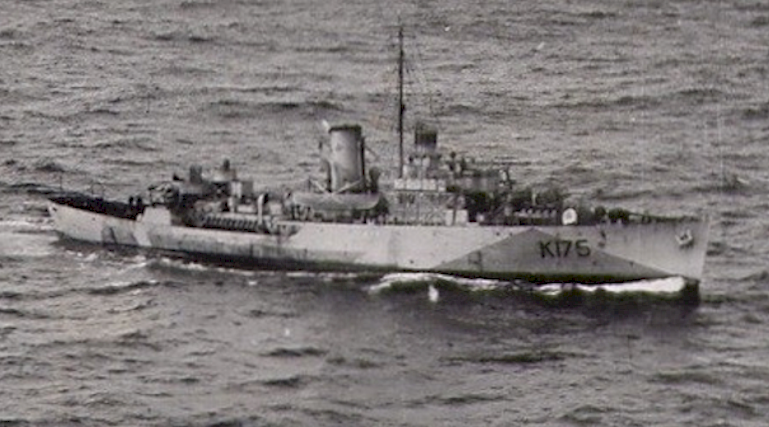

A massive 200-foot warship like K175 was not painted with its geometric patterns for aesthetic purposes. Against a featureless sky and sea, such a vessel could not be hidden from shoreline observers, passing submarines or overhead aircraft. However, it could be disguised or obscured in a disruptive camouflage scheme. Obtrusive patterns, painted on the vertical surfaces and horizontal decks of a ship confused the identity as well as the directional course of the vessel.
In the First World war, ships were painted in dazzle patterns using a bright colors such as pink, yellow, blue or green. Later, colour experts determined that the contrast between dark and light mattered more than colour because when an object is viewed at a distance the vibrant colours appear muted as shades of grey instead of their true colors. World War II camouflage experts settled on conservative hues to help ships blend into the sea around them and they chose patterns that could be at least obscured in terms of how a vessel might be interpreted.
When he is peering through his periscope, a submarine commander can be confused by some geometric or abstract patterns. That was because he did not have constant visual contact and also had to limit periscope exposure. Key variables such as distance, course, and speed
were essential for a commander to correctly position the
submarine
for an intercept. Under ideal conditions, certain camouflage designs were deceptive. For example, a warship might appear to be sailing towards the right of the viewer when actually the vessel was moving oppositely, sailing away and to the left. An aircraft pilot could adjust course and follow a warship, but a submarine commander did not have such an definitive choice and could be misled into calling off an attack.
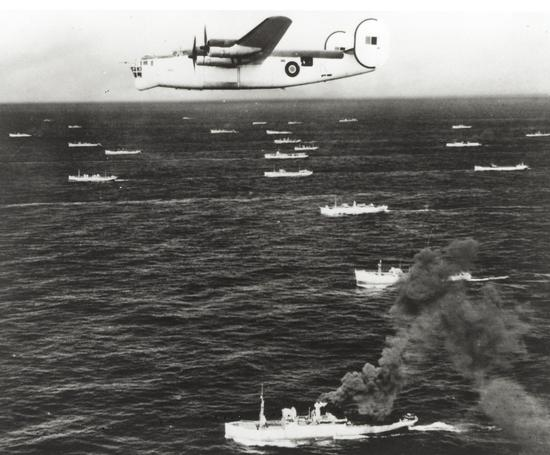
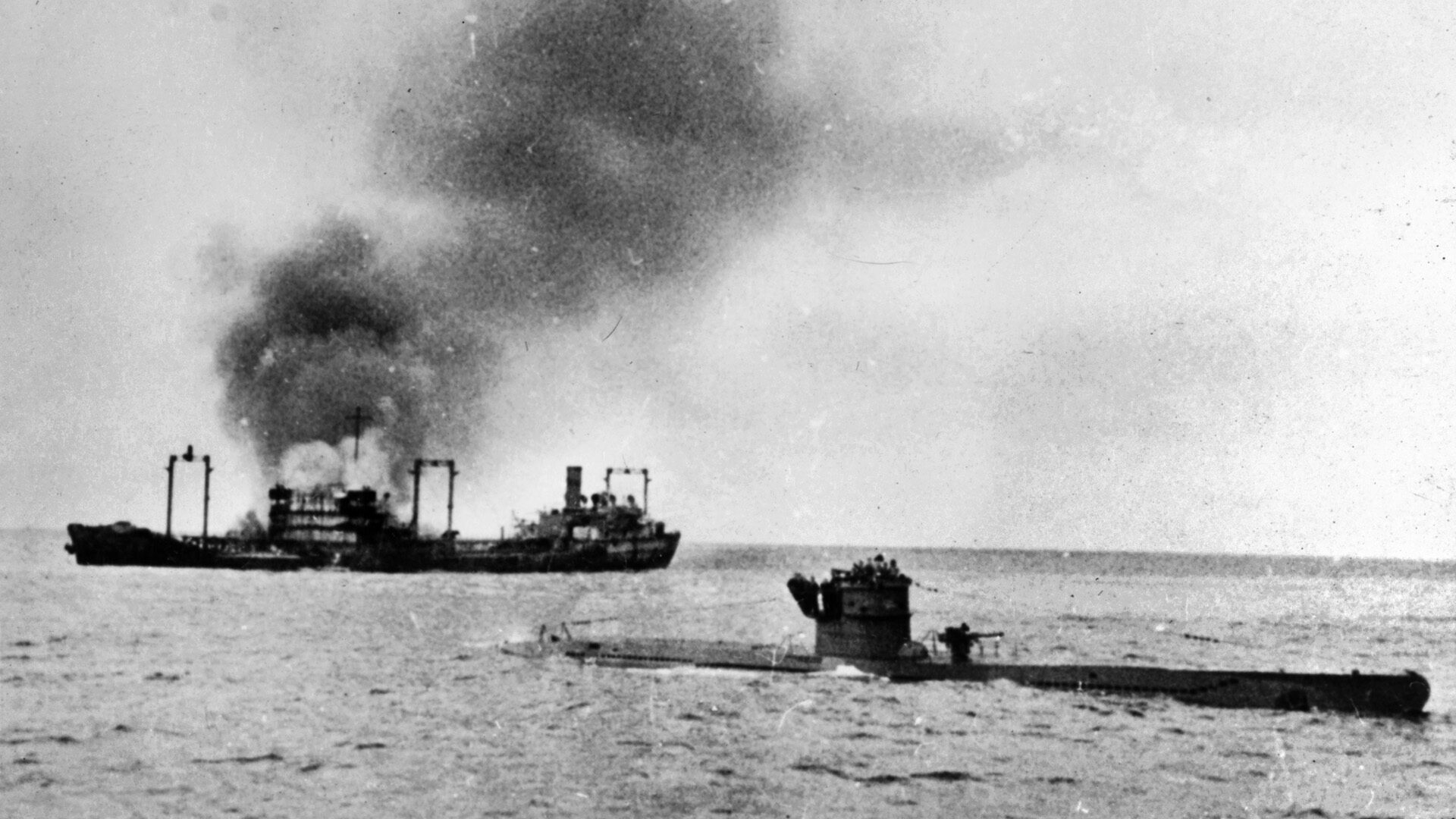
The rapid expansion of Nazi Germany threatened the lives of millions of people. Imports of food, oil and raw materials from North America were important to Europe in peacetime; in war, these goods became a matter of life and death to millions in the British Isles, occupied Europe and the Soviet Union. To choke off these supplies Nazi German attacked merchant ships crossing the Atlantic. To defend this lifeline the Allies, particularly Britain and Canada, needed more warships and a massive injection of manpower. Ship Naval recruitment began in earnest.
In the Battle of the Atlantic, the primary role of the Royal Canadian Navy was protecting Allied convoys and hunting Kriegsmarine submarines. The constant demands placed upon it necessitated the rapid expansion of its a home navy fleet of six destroyers to 330 warships which in turn required facilities, training, support and above all, manpower. Canada's 2000 man navy was revolutionized to 100,000 personnel. Thousands of hostilities-only personnel joined the navy.
Prior to recruitment and training the story of the individuals who served on HMCS Wetaskiwin is varied. They would have shared similar experiences in naval training. The story of HMCS Wetaskiwin is a reflection on their shared experiences while serving in the Battle of the Atlantic.
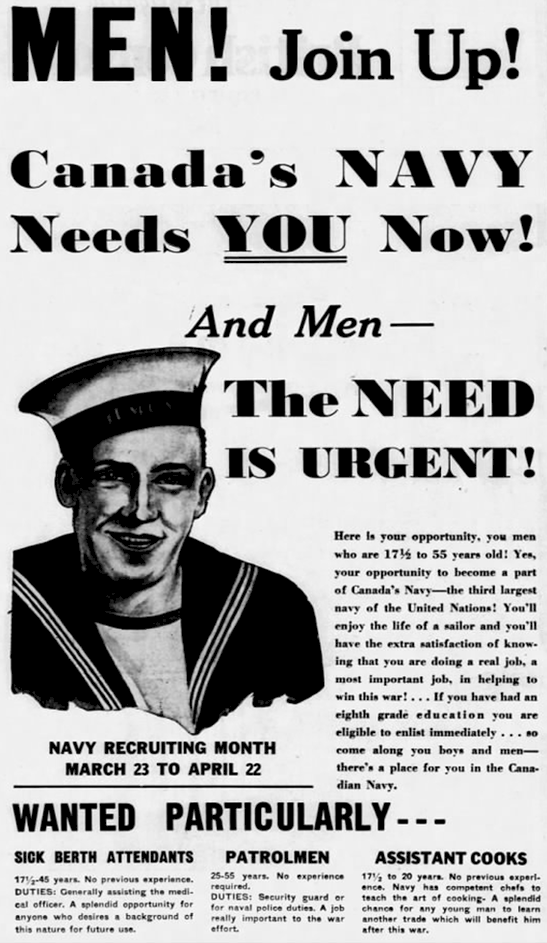
In the pre-war years, adventure, travel, access to education, or a stable navy career might entice boys to join cadets. After economic downturns and widespread unemployment during the preceding depression years the navy offered financial stability. During World War II incentives might have been similar. Their stories also tell that the driving force for many navy recruits was a patriotic sense of purpose and heroism.
Newspaper editorials, recruiting posters, political
speeches and lectures from the pulpit implored men to serve. Men and women from varied backgrounds were drawn to the idea of contributing to a cause greater than themselves. Further influenced by seeing friends and family join the military, they left their homes and families to report to a naval base training site.
The compliment of the HMCS Wetaskiwin was six officers and seventy-nine crew. Many of the officers serving on warships were navy men called back from retirement. That was the case of Wetaskiwin's Lt. Commander G.S. Windeyer. Some of the crew may have been cadets from the Royal Military College of Canada. Most of the crew of HMCS Wetaskiwin and their Canadian equals were newly recruited junior enlisted sailors, who joined the service for war duties. They were called hostilities-only ratings. In other words, they left cities, rural towns and farms and reported to a designated naval training centre because they felt it was their duty. Few had ever been to sea.
In fact, 40 per cent of the navy strength came from Saskatchewan, Alberta, Manitoba and British Columbia, even though those provinces comprised 28 per cent of Canada's population.

The principal Naval Training Centre for Western Canada was HMCS Naden, one of the naval shore facilities at Esquimalt Naval Base, Victoria, a place that had served numerous military purposes for the better part of a century. Naden was surrounded by rich military history, a strong sense of tradition and also inspirational reminders of a long line of service members who served before. The Wetaskiwin crew may have also trained at HMCS Nonsuch (Edmonton) commissioned as a tender to HMCS Naden in 1941 or any one of the other RCN training bases: HMCS Tecumseh (Calgary), HMCS Stadacona (Halifax), HMCS Fort Ramsay (Gaspé Bay), HMCS Conestoga (Galt) or HMCS York (Toronto).
Royal Canadian Navy's shore-based facilities, training camps, schools, barracks, port operations, dockyards, warehouses and administration/logistics headquarters were named using the prefix HMCS (His/Her Majesty's Canadian Ship). The RCN adopted this naming tradition from the Royal Navy.
Under their Naval Discipline Act of 1866 the Royal Navy could only exact rule over officers and enlisted sailors carried or transported on a vessel. Therefore, navy training facilities and barracks were housed in old ships that were afloat in ports but incapable of going to sea. Eventually, when the Royal Navy outgrew the floating old hulks it commissioned land as ships and named the facilities as nominal depot ships. Many land-based naval facilities were unofficially called stone frigates, a term first used in 1804 during the Napoleonic War. Navy men assigned to a stone frigate were bound rules and regulations that dictate the conduct of RCN naval personnel and address various aspects of naval operations, and uphold the navy's mission.

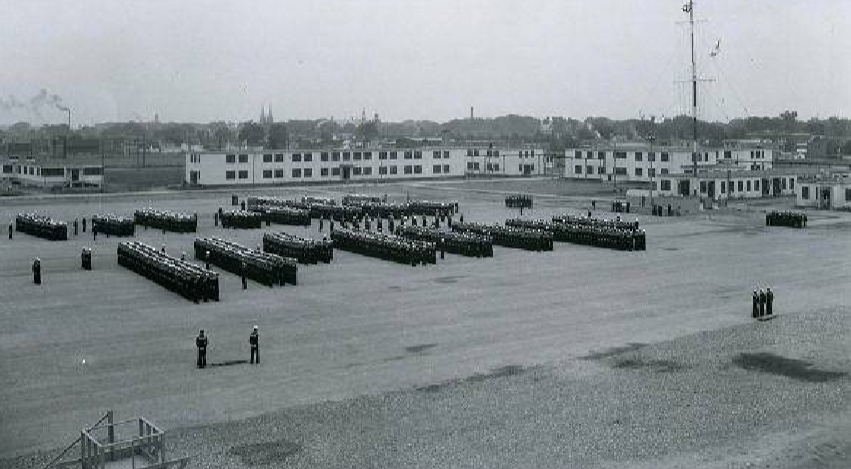
(source: Gov't of Canada)
Upon reporting for duty a recruit exchanged civilian clothes for a military uniform, underwent a physical examination and sat for the customary haircut before introduction to an unfathomable language that was the sailors' own and indoctrination to the discipline and regimentation of the navy system.
For most recruits, it was not easy to slide into the sailors' structured daily routine. They learned that flogging with a cat-o’-nine-tails or running the gauntlet were obsolete punishments. Yet, not all men were primed to obey the navy's strict orders and the discipline to live in the confinements of a warship. They had but eight weeks to become accustomed to the traditions, routines and actions to live at sea with sixty or seventy other men and the diligence to engage in battle.
What would be so completely familiar to a navy sailor one or two hundred years ago was basically built into navy traditions: how to salute both as greeting and mark of courtesy and to salute when crossing a brow onto something still called a quarterdeck; that a routine summons is called a pipe; what it meant to ring a ship’s bell to initiate the ceremony of colours; the importance of the high-pitch whistle of a bosun’s call; the precious distinction of the toasts of the day; how to salute other ships; the solemness of Taps and Reveille for military funerals; that the ship should be all spiffed up for the afternoon walk-about; and absorbing why the Naval March is Heart of Oak. Also, in those eight weeks the navy prepared the recruit for what lay ahead in the life of a sailor at sea or on shore.
Due to the urgency of war, ratings got basic training in weapons and communications before being funneled through various other training areas to serve in either a support role ashore or combat position at sea - engineer, gunner, shipwright, supply officer, radio operator, code, signalman, mechanic, analyst etc. Training was longer and more intense for recruits that had the aptitude to be visual signalmen, coders, radar operators, wireless telegraphists, and radio artificers (skilled technicians in repairing radio equipment).
For those destined to serve on a ship, the navy concentrated training exercises that prepared ratings for the intense physical and psychological demands of living at sea. Ratings lived and trained in an environment that simulated sea conditions.
To become an able seaman ratings were tasked with learning traditions, terminology, mustering, and communication while gaining general knowledge of the ships systems and basic training in the operation of equipment, general engine maintenance, battle station positions, navigation and other at sea essentials.
They had to learn to share living space with other men in cramped condition on a ship at sea. Recruits were expected to perform jobs such as upkeep of the ship, be that cleaning or proper storage of necessary provisions.
Recruits spent a lot of time on roofed platforms to become familiar with the command centre of the ship and the communications relayed from the bridge to stations where physical control of the
ship was exercised by navy personnel. Ratings trained on a rolling bridge that rocked back and forth and sideways to simulate the pitching and the
rolling of a ship on the sea. The navy did this to help ratings learn how to maintain balance on an unsteady platform and still be able to complete tasks such as use a weapon, send legible messages, control and maintain equipment or save a life.
Recruits were expected to make good use of their time. If not on duty, recruits were expected to be proactive in honing their profession - education and preparation. They could take on challenges, learn to perform specialized duties or gain some knowledge and experience in a multitude of essential responsibilities.
Every able seaman had a job on a battle ship. Every job was vital. Every able seaman was anxious to be assigned to a ship.

K175 was launched on July 18, 1940. She went through her shake-down cruise and acceptance trials in the Pacific Ocean, at Esquimalt, British Columbia. She could not be commissioned until the navy tested her maneouverability and seaworthiness as well as verify that all her mechanical, electrical, navigation systems, and safety
features were fully operational under a variety of environmental conditions.
Esquimalt Naval Base was critical to Canada's western defence as well as a hub of naval training, logistical support, and ship building for the Royal Canadian Navy's massive wartime expansion. K175 began sea exercises with many ratings that had been trained at HMCS Naden, a Naval Training Centre for western Canada at Esquimalt.
After a brief time patrolling out of Esquimalt, K175 got its commission as HMCS Wetaskiwin on 17 December and received notice of war duty to join the Allied convoy system in the Battle of Atlantic (1939-1945).
Under the command of Lt. Cdr. Guy Stanley Windeyer, HMCS Wetaskiwin left Esquimalt on 17 March 1941 with HMCS Alberni and HMCS Agassiz on. Bound for Halifax via the Panama Canal, they stopped for fuel at San Pedro, California. While there, Canadian-born,
Academy Award-winning actress, Mary Pickford hosted a party for the companies of the three ships.
On 13 April the three corvettes arrived at East Coast Port where they joining corvettes Chambly, Cobalt,
Collingwood and Orillia.
East Coast Port was Halifax Harbour, but it was rarely identified as such. Not only the military, but the media, the city and residents recognized the extreme need for caution. They lived on the rim of danger because their port was the principal staging point for the war in Europe and lay exposed to the Atlantic. In the city, tensions were high - wartime restrictions, security requirements, night-time blackouts, searchlight
installations, air-raid sirens, Civil Defence practice, patriotic marching songs, the presence of troop transport ships reminded citizens and military alike that danger and death
lurked just beyond the submarine net that stretched across the mouth of Halifax Harbour.

The crew of K175 had very little time to adjust to the war-crowded Halifax environment. They underwent an intense, uncompromising training program under Lieutenant-Commander James Douglas “Chummy” Prentice.
Prentice had dual positions of responsibility. He was Senior Officer, Canadian Corvettes, charged with operational training of corvette crews, and he was also commanding officer of another corvette, HMCS Chambly. Prentice was a retired navy man, ranching in British Columbia when he was asked to return to service for the Battle of the Atlantic.
The navy needed an experienced saltwater sailor and forward-thinking strategist, someone astute to develop tactical doctrine for all the Royal Canadian Nave corvettes. Since the Canadian Navy was bearing the brunt and shouldering the weight of protecting the convoys against U-boat attacks, they needed an innovative and intense training program covering various operational scenarios that were mostly unfamiliar to the crews and commanders of the corvettes.
Prentice knew how to handle ships and was keen on the potential of the Flower-class Corvette. Many navy men saw the corvette as a slow poorly armed warship, a cheap vessel that could be risked in combat. But, Prentice, clever and inventive, saw the potential of the corvette as the ideal sub-hunter. He was eager to train a new fleet of sub-killers.
Prentice used a different approach to training hostilities-only ratings than training regulars. He had high standards and insisted on hard work, but he also understood that corvettes were crewed by young men who had little sea or battle experience. In other words, Lieutenant-Commander Prentice was given the tough assignment of turning the inexperienced recruits on the Wetaskiwin into trained and disciplined sailors. He had less than nine weeks to pioneer a program that would train the crews of these first corvettes for the rigors of combat in the North Atlantic, where the men would be pushed to their limits. He understood they were men fighting for their country, but they were also sons away from home for the first time and fathers missing their children. He had to prepare them to have the discipline to live at sea in adverse conditions, to acquire the technical proficiency to win a war at sea, as well as find the spirit and determination to win within themselves. Without doubt he knew they would have to learn a lot on the job in the middle of a raging war.
Prentice was keen to train corvette commanders to use one of his favourite tactics - the quick attack. Sea smart and experienced though they were, Prentice knew he was working with several ships' commanders who lacked real time battle experience.
Such was the case of Australian born Lt. Cdr. Guy Stanley Windeyer, 40 years of age, who commanded the Wetaskiwin. Windeyer was twelve when he was sent to the Naval Academy in England. At the tail end of World War One he was old enough to join the Royal Navy and was educated at Cambridge. Windeyer was a midshipman in H.M.S. Thunderer during WW I, and
was in action in the Baltic Sea. After which he was stationed in Tokyo as a language officer for the British Embassy. After postings in China and Malta he retired to British Columbia where he and his wife took up dairy-farming on Vancouver
Island,. Like Prentice, he was pulled from retirement in 1940 to take command of the corvette. Windeyer had sea smarts and war experience, but limited knowledge of battle manoeuvres against submarines.
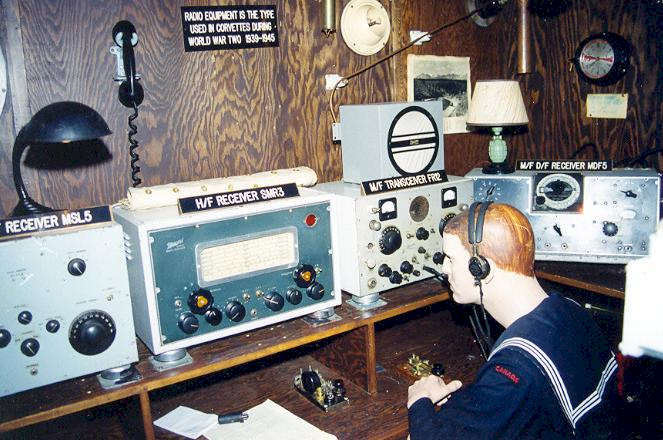
This restoration for a naval museum is close, though not 100% correct, in showing radio equipment aboard a corvette.


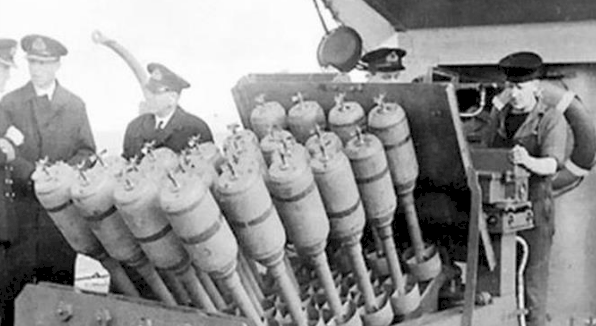
Training Sub-Killers
Under Prentice the crew of HMCS Wetaskiwin underwent intense training exercises at sea. Exercises took the form of warship support reinforcing the escort of convoys coming under attack. The Wetaskiwin and the other five corvettes needed to be able to work effectively to protect a convoy.
Exercises included ship-handling and days of group maneuvers at sea. Prentice placed heavy emphasis on efficient communications between the men on a ship, but more importantly the signaling between vessels. The crew of the Wetaskiwin got practical experience working with target and barrage kites, doing anti-submarine sweeps in the
entrance to Halifax Harbour and screening convoys during the first
leg of their journey out of Halifax to sea.
The most critical training the crew of HMCS Wetaskiwin received was in anti-submarine warfare. The key to such an operation is the ability of the asdic operator to differentiate marine sounds from a those of a submarine and then track that target so the corvette can gain strategic advantage and take action. Maintaining contact was vital. So, the corvette captains had to maintain their best sonar speed throughout the whole attack process and attack with precision.
In those days, there was no substitute, no simulation for using a sonar to detect and track a real submarine at sea. Prentice was fortunate to have a real submarine at his disposal for anti-submarine warfare training exercises. The Royal Navy had assigned a Dutch submarine to Halifax.
Wetaskiwin's Asdic Operators were given three weeks of ping time learning to use their sonar system to locate the Dutch sub and track its elusive movements. Meanwhile the speed of the ship could drown out the sonar and contact could be lost. Any sudden change in propeller noise could alert a U-boat of a looming attack and give the sub time to alter course or dive to the deeper. Communication from the Asic Operator allowed Lt. Cdr. Windeyer to determine Wetaskiwin's optimal speeds while getting a sense of timing and what factors constitute tactical advantage. Windeyer and the other commanders were learning to work together.

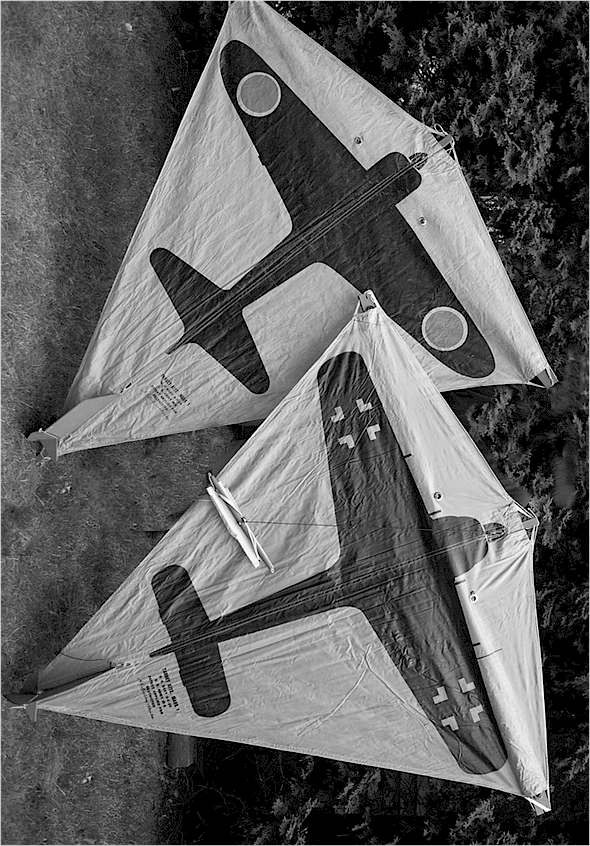

Being launched by sailor on mast.
HMCS Wetaskiwin started out with a shortage of equipment: kites and signalling equipment. The signalling equipment included 20-inch signal projectors, hand-held Aldis lamps and radio-telephone.
There were two kinds of kites used on Canadian corvettes, a target kite and a barrage kite. Crews required training to finesse working with both types.
The triangular target kite was used in defensive training. It was manually controlled by a reel and harness worn at the waist to make the kite loop, dive, climb, and make figure-eights. Emblazoned on the centre of the kite was a picture of an enemy aircraft. The kite could be extended hundreds of meters out over the water for the gunners to practice tracking the image of the aircraft as it veered about and also practice aiming and shooting at the kite as if it were a real enemy
plane.
The barrage kite was box-like with a wing span of about thirteen feet. It was strong and steady enough to hold a slender cable and pull it high up into the air where the cable could dangle for extended periods of time. If a low flying enemy aircraft flew in to attack the ship it risked flying into the cable,
which could sever a plane’s aluminum wings.
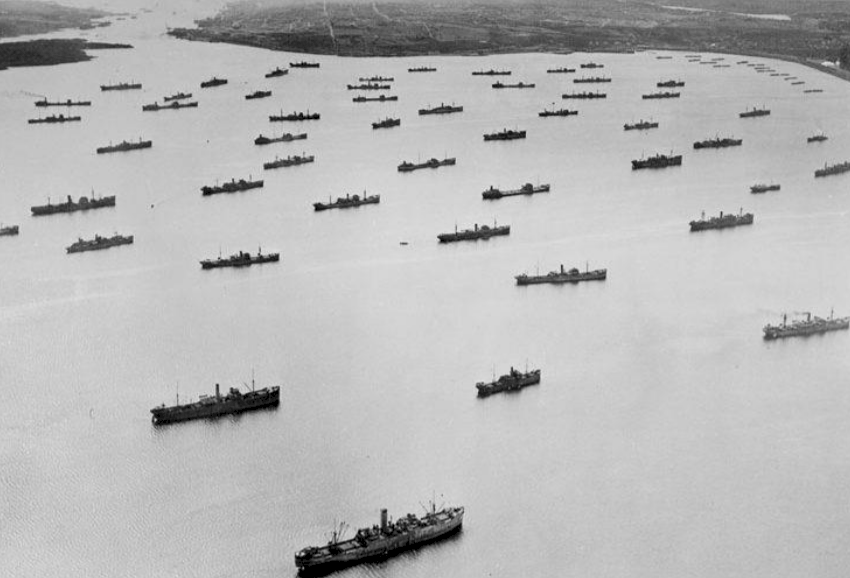
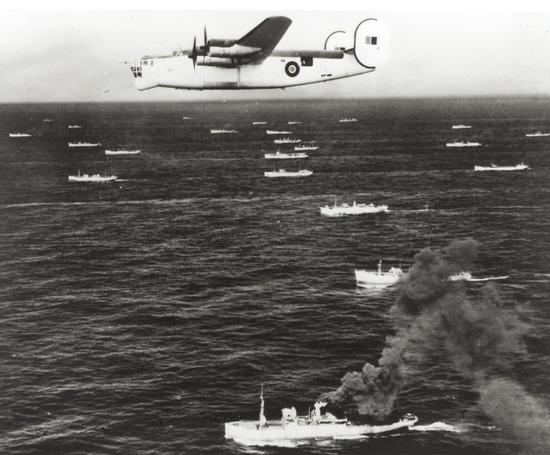
On the 6th May the Wetaskiwin had escorted that Convoy HX 125 - 40 British and Norwegian merchant vessels - to the armed merchant cruiser meeting point after which she returned to Halifax along with 12 ships that for some reason (mechanical or unstable load issues) returned to port and were scheduled to leave with the HX126, a convoy of 33 merchant ships leaving on 10th May. After more practical training, on the 16th Wetaskiwin departed Halifax with Convoy HX 127 with 46 Norwegian, Dutch and British vessels and again returned to port. Both convoys included ships carrying explosive cargo destined for Liverpool.
While Prentice was training corvette crews in anti-submarine warfare, he was also steering the HMCS Chambly through secret sea trials to test two new Canadian technologies. The first innovation was a prototype of diffused lighting
camouflage or counter -illumination to conceal ships from the enemy and the second device was Surface Warning Model 1, Canadian (SW1C) an experimental anti-submarine radar that could track the course of a U-boat on the surface. A submarine on the surface was undetectable by ASDIC.
For nearly six months the RCN had been experimenting with diffused and filtered lighting to eliminate the contrast in luminosity between a ship and the darkened sky. Submarines preferred to attack convoys at dusk or at night because when darkness appears it is never completely black; a ship stands out as a dark silhouetted target against the horizon. The right combination of lights projected onto the sides of a ship, could make its nighttime glow match its background and thus conceal its presence. In May of 1941, that round of experiments with the newest diffused lighting protype reduced
Chambly‘s visibility by 50% to 75%, enough for the Navy and National Research Council to justify development of a more robust version. Besides the advantage of camouflaging ships from U-boats, having that kind of camouflage on a corvette would allow the Allies to be more stealthy in hunting submarines and could be designed to chamelionize aircraft.
The SW1C was a combination of two technologies already in use. RCN used the Canadian designed Night Watchman Radar System to watch for enemy ships or submarines attempting to enter Halifax Harbour. The Night Watchman was permanently installed on the approaches to the harbour in 1940. It was the first radar of any design to be in operational use in North America. By combining the technology from the Night Watchman with fragments of the British aircraft-mounted ASV Mk. II radar, the RCN designed a new surface warning radar system that could be outfitted on a warship. The navy gave Prentice the opportunity to experiment with it to track the Dutch submarine as it maneuvered on the surface in dense fog under near zero visibility conditions. The new SW1C out performed traditional surface plotting techniques. Outfitted with a reliable surface radar combined with sonar to track a submarine underwater, the corvettes would be better able to track U-Boats.
That advantage was effective until late 1942, when the German U-boat fleet obtained the Metox radar detector that could detect the Canadian SW's long before the corvette's radar operators could define the presence of a German sub.
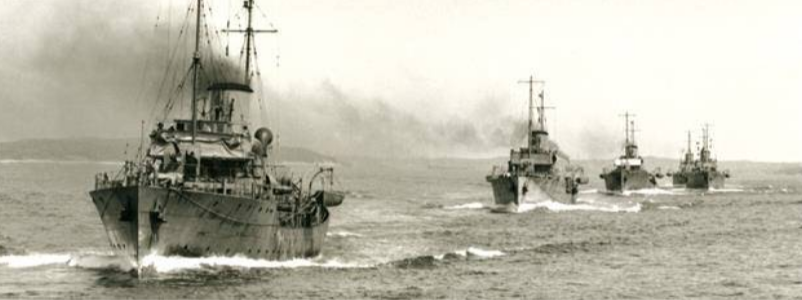
After escorting these two convoys out of Halifax, HMCS Wetaskiwin received her assignment to join the newly formed Newfoundland Escort Force (NEF), their new base of operations in St. John's, Newfoundland. The Wetaskiwin, under Lt. Cdr. Guy Stanley Windeyer, the Chambly under Prentice and five other corvettes were to form the nucleus of the NEF.
Before the Wetaskiwin departed Halifax, word arrived that convoy HX 125 reached Liverpool without incident. The British Commodore of HX 125 reported:
More ships to be fitted with kites - more kites to be supplied to ships aleady fitted and a spare wire if possible. Masters are __ to fly them but are afraid of losing their last kite. Considerable wastage is inevitable. 62 ships put up 16 kites between them. There were no kites at Halifax.
However, convoy HX 126 had been attacked by Wolfpack West, a contingent of 23 U-boats operating as one unit in the North Atlantic.
In various zones of its Atlantic crossing, HX 126 was under escort by Allied ships. The attack took place in the unescorted zone known as the Mid-Atlantic Gap. Over a three-day period (May 19-23) nine merchant ships were sunk, five of which originally were with HX125. Convoy HX 127 was still safely enroute.
Surviving ships from HX 126 reached their destination on 29 May.
By this point in the war, three merchant ships were being sunk for every one being built and eight U-boats were being launched for every one that was sunk.
On 23 May, the Wetaskiwin departed Halifax for St John's, Newfoundland with the other corvettes.
The crew of the Wetaskiwin knew they were about to engage in complicated operations that would really challenge their combined abilities. They were assigned to escort ships through the dreaded Black Pit where the deadly efficient U-boats hunted for convoys.

German Kriegsmarine sent out their warships and U-bootwaffe (submarine force/U-Boats) from their bases in northern Germany and from occupied Norway to attack Allied shipping convoys crossing the Atlantic. The Allies impeded those efforts in the North Sea by occupying the Faroe Islands in April 1940.
Iceland was a neutral country, but its location in
the North Atlantic was strategic to the Allies and the
Axis powers. To deny Germany access to another north-western base of operations in the Atlantic, Britain moved to occupy Iceland in May 1940 and set up several military bases.
The United Kingdom had also taken measures to extend the range of the British and Canadian escorts to cover more of the Mid-Atlantic Gap and by mid spring 1941 the Black Pit had been narrowed to roughly 700 nautical miles (1,300 km; 810 mi).
Germany, however, with their occupation of France and the help of Italian submarines, had found the means to move their U-boats still deeper into the western Atlantic Ocean just outside the fuel range limits of the Allied escorts vessels and aircraft. Attacks on merchant shipping were on the rise. Moreover, many of these attacks occurred south of Iceland.
It was a treacherous time. Britain's Admiralty had not figured out a way to combat against Kriegsmarine's new wolf-pack tactics where U-boats roamed the Atlantic in long patrol lines, sinking Allied warships and merchant vessels with impunity. Convoy losses were significant. Germany dubbed it their Happy Time.
By this point in the war, three merchant ships were being sunk for every one being
built and eight U-boats were being launched for every one that was sunk.
In response, Britain was forced to implement a new plan for convoy protection. First, the British Admiralty formed the Western Approaches Command under the Royal Navy - its primary aim, the safe and
timely arrival of convoys. Its base of operations Liverpool, England. Their new Atlantic strategy involved the Dominion of Newfoundland, Occupied Iceland and the Royal Canadian Navy.
While HMCS Wetaskiwin was training in Halifax, Britain deployed ground reinforcements, an infantry battalion and artillery battery to augment the military presence in Iceland to 25,000 troops.
Next, the British Admiralty called for the establishment of the Newfoundland Escort Force (NEF) as a subordinate command under Western Approaches Command. With the positioning of the NEF and a forward base at St. John's Harbour the RCN could extend coverage of the Canadian convoy escorts more than 900 kilometres further into the Atlantic, which was nearly a full quarter of the way closer to the Mid-Ocean Meeting Point off Iceland and could fill
the gap in protecting convoys between British escorts and Canadian escorts. The NEF made it possible for shorter-ranged warships and a smaller escort fleet to be used through the Mid-Atlantic Gap.
They also decided to reduce the size of the convoys and carefully coordinate convoy movements in crossing the Atlantic.
Convoys, assembled at Sydney Harbour and Bedford Basin in Halifax, were to be escorted by the Royal Canadian Navy to the WOMP (Western Ocean Meeting Point) the north-eastern fringe of Newfoundland just east of the Grand Banks. At the WOMP the NEF would assume escort duties to protect convoys to the MOMP (Mid-Ocean Meeting Point off Iceland) where Royal Navy escorts based in the Western Approached would take over escort of the convoy to Liverpool or Northern Ireland.
The Admiralty also understood the need to reinforce Allied defences in Iceland as well as in the fog shrouded waters of the Grand Banks. Canadian warships that had been deployed to convoy duty in Britain and the Western Approaches were being reassigned to bases in Canada and Newfoundland.
With all these strategic moves taking place, the British Admiralty gave the Royal Canadian Navy command of the NEF, the NEF zone and the northwest Atlantic from New York to the Arctic Circle, as well as any allied navies operating in the zone. The Canadian Navy was to bear the brunt and shoulder the weight of the U-boat war. Lacking adequate training and still not being outfitted with the essential equipment that the British corvettes had, Canada could have been reluctant to accept the request but the RCN complied with the British Admiralty's new plans for convoy protection. This was the first foreign operational command the Royal Canadian Navy every undertook.
The new Commanding Officer Atlantic Coast and in command of the NEF was career navy man Commodore Leonard W Murray of the Royal Canadian Navy. Before being reassigned, he was in command of the fleet of Canadian ships that had been dispatched to defend the United Kingdom. He was also one of the architects of the new Atlantic strategy and had strongly advocated for Canadian operations in the North Atlantic. He was more than ready to spearhead the charge towards Canada's formation of a small ship anti-submarine navy.
Murray was career navy. He joined in 1913, served throughout World War One, and steadily moved up the ranks. He served on several ships until given command of the destroyer HMCS Saquenay and then navy bases on the east and west coast of Canada. At the outbreak of the war, Murray was Director of Naval Operations and Training and was appointed Deputy Chief of the Naval Staff. He traveled across Canada convincing retired Royal Navy officers, such as Lieutenant-Commander James Douglas “Chummy” Prentice and Lt. Cdr. Guy Stanley Windeyer, to return to service for the war.
Between WWI and his commands he served on British battleships and studied at the Royal Naval College in Britain which gave him broad connections in the Royal Navy. After twenty-eight years of naval service on both side of the ocean Murray had seafaring expertise and above all he was well regarded for being definitive in terms of strategy, tactical deployment, direct confrontation with an enemy and diplomacy. He was well loved by the lower deck.
The convoy system spanned the Indian Ocean, Mediterranean, Caribbean, Arctic Ocean, North Sea, UK coastal waters, and Atlantic Ocean from South Africa to Iceland. At any one time there could be up to 20,000 people aboard the ships crossing just the Atlantic at the same time. Between 3 September 1939 and 31 May 1941, KriegsmarineU-boats torpedoed 83 ships from convoys and sank many other merchant ships that had straggled from convoy protection.
All convoys were classified according to
speed and destination.
Convoys designated as HX were British bound
convoys carrying explosive cargo (oil, munitions). Slow convoys were typically comprised of merchant vessels that were older, weather-beaten,
and prone to breakdown.
In 1941, fast convoys were scheduled to depart from Halifax or New York every six days and were expected to make the crossing to Great Britain in 13 to 15 days. Slow
convoys also departed every six days, common speed 7 knots, and took 16 to 20 days to sail from Halifax or New York to Liverpool.
H (Homebound) - convoys bound for Britain
O (Outbound) - convoys returning to Halifax or Sydney
HX - fast British (homebound) convoy carrying explosive cargo sailing from Halifax or New York
SC - slow convoys, regardless of destination sailing from Sydney, Halifax or
New York, their common speed 7 knots. From Halifax to Liverpool took about 20
days.
ON: westbound convoys sailing from Great Britain to North America
JM - convoys from British ports to Murmansk
PQ - convoys from Nova Scotia via Iceland to Murmansk
M - convoys sailing to the Mediterranean
There simply was not enough ships and manpower in the Allied defences to protect the convoys. The British Admiralty, in ultimate control of the convoy system, made decisions from a broad strategic perspective, allocating resources and manpower to fight a war that expanded far beyond the coastline of the Atlantic Ocean.
Though their reasoning might be justifiable at the time, in retrospect their allocation of resources placed Canadian corvettes in greater danger.
With a lack of properly equipped and trained vessels rotating through the command the Canadian navy was stretched to its limits. With orders from Western Approached and the British Admiralty, there was very little the Royal Canadian Navy could do to improve the quality and efficiency of the NEF or Canadian escort groups.
Canadian ships lacked crucial radar and HF/DF radio-interception equipment while the British ships were equipped with the more precise equipment. With crucial newer technologies the Canadian warships could have used the poor visibility of the fog-shrouded waters of the Atlantic to more advantage, intercepting enemy communications and track U-boat wolf packs.
Destroyers were crucial for their speed in targeting and sweeps against submarines. The RCN
was short of destroyers and those assigned from Britain were mechanically unreliable. Warships
were lost in battle or taken out of service for repairs and refits,
further reducing the available number of destroyers for escort duty. The RCN lacked destroyers. The RCN worked with too little equipment or inadequate technology. There
was very little reserve force that could be sent to augment personnel or ships. Vessels damaged by the sea or combat delayed their refit schedules, making those ships out on escort less
capable. Many of the ratings were assigned to duty with insufficient training.
NEF operations commenced with a lack of ships and fully trained manpower.
When
a convoy left a harbour it was to be accompanied by corvettes, minesweepers, and
short-range destroyers. Ideally, a convoy of 60 merchant ships would have an escort of at least 2
destroyers and 4 corvettes, a ratio of one escort for every ten merchant vessels.
Originally, the NEF Command was supposed to have sixty or more vessels at its disposal. However, operations got underway with thirty-eight warships. The Royal Canadian Navy assigned twenty-three: six destroyers and seventeen corvettes. The Royal Navy suppled an additional seven destroyers, four sloops and four corvettes. Many of those warships were still enroute when HMCS Wetaskiwin and the other corvettes reported to the NEF.
In the exigent circumstances, the RCN and the NEF had no choice but to substitute Flower-Class corvettes for destroyers. Though, by Lieutenant-Commander James Douglas Prentice's high standards, the corvettes had not yet achieved an
acceptable level of competence.
Corvettes were not to be assigned to a single convoy for the entire journey. They were to have rotating assignments, providing escort for specific legs of the voyage between Halifax and Liverpool. Theoretically, the ships of the NEF were to get at least a week for rest and maintenance between the inward and outward legs of each voyage but this rarely proved possible.
This meant that any plans for Prentice to have the facilities and time for more training exercises was also doomed. The workup training the ships and men would need before being committed to operations was an unaffordable luxury. Still, the men and ships assigned to the NEF did have nine weeks of hands-on training, more exposure than perhaps any other allied escort warships thrust ill-prepared into service in the fall of 1940.
Both Murray and Prentice knew that until more recruits could be trained and warships launched, the resources and capabilities of the men, vessels and equipment at their disposal would be taxed to their limits.
The men serving on the Wetaskiwin, like the other warships, would be under enormous pressure.
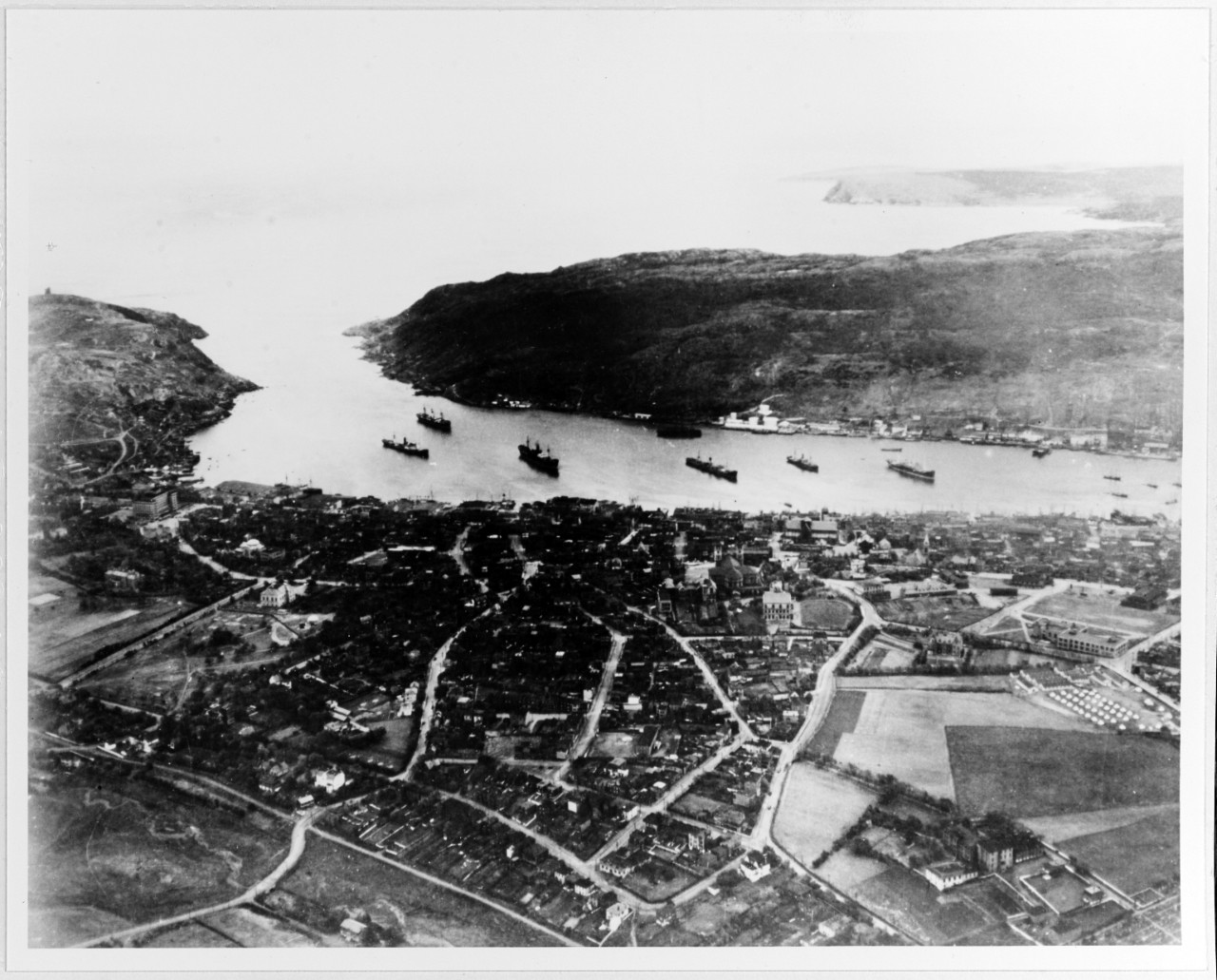
Courtesy of Rear Admiral S.E. Morison collection
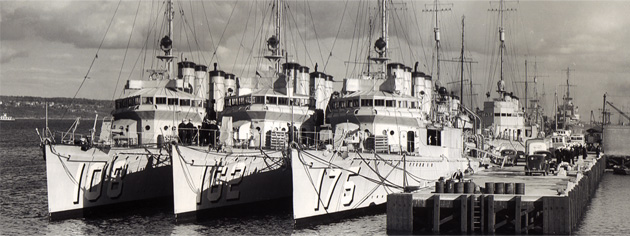
When HMCS Wetaskiwin sailed into the harbour at St. John's, Newfoundland, her Canadian crew had arrived in a friendly, Allied country. At that time, the Dominion of Newfoundland was a country separate from Canada and part of the British Commonwealth.
When Britain declared war on Germany in September 1939, members of the British Commonwealth, including Newfoundland and Canada were at war, too. Newfoundland's proximity to Europe made it the first line of defence against an attack on North America by Germany. The country was unable to defend itself. From the beginning of WWII Britain placed the Royal Canadian Navy in command of the defence of Newfoundland.
Wasting no time, Canada built air bases, coastal defenses and naval facilities in Newfoundland. They expanded the air base at Goose Bay. Goose Bay was crucial for surveillance flights as well as refueling Allied aircraft. Canada built an RCAF station at Torbay (now St. John's International Airport) and expanded the naval base at St.
John's. To defend other strategic locations in Newfoundland, Canada installed artillery batteries.
One of these locations was Bell Island in Conception Bay. Bell Island was a major iron ore producer, a critical
source of raw material for steel mills in Canada and Britain for the Allied war effort. Prior to the war Germany was one of the largest
customers of iron ore from Bell Island. Of course
the Axis Powers had first-hand knowledge of Bell Island's strategic value and
wanted to cut off that supply.
The people of Newfoundland were just becoming accustomed to a Canadian military presence when in January 1941 American engineers, civilian personnel, and troops arrived in St. John's to build an American air base. The USA gained military base rights in Newfoundland at St. John's, Argentia, and Stephenville in exchange for providing the United Kingdom with fifty destroyers - a deal solidified through the Leased Bases Agreement with Britain. This agreement gave the USA a ninety-nine year lease on British territories in Newfoundland, Bermuda and the Caribbean. American detachments were stationed alongside Canadian troops at
the Gander and Goose Bay airfields, as well as in a number of smaller
communities of strategic importance, where for example radar sites were installed.
The formation of the NEF triggered another influx of sailors and navy support personnel. Within a few short weeks, the British Admiralty called upon the Royal Canadian Navy to concentrate its resources at bases in Newfoundland for the defence of trans-Atlantic convoys.
At the end of May, Lt. Cdr. Guy Stanley Windeyer guided HMCS Wetaskiwin into the busy harbour at St. John's, Newfoundland. They secured to a rotting wooden wharf at the southern end of the harbour. They had just sailed into the most highly militarized place in North America. The harbour entrance, a few hundred yards away, was the front door that opened up to the Battle of the Atlantic.
The population of St. John's had hovered at about 40,000 at the outbreak of World War One. With the appearance of Canadian and American military personnel the population spiraled to 100,000. For the people of St. John's the arrival of the ships and navy personnel for the Newfoundland Escort Force was sudden. There was little time for preparations to transition from being just a defended harbour to a major base of operations for anti-submarine patrols. As they had done in the previous months, the people of Newfoundland responded with support as best they could on such short notice.
In Newfoundland, people understood that Britain was alone in Europe. People were on rations and their freedom was at stake. Imports of food, oil and raw materials from North America were important to Britain's economy in peacetime; in war these goods became a matter of life and death to millions in the British Isles and occupied Europe. (Six months later, the German Reich invaded the Soviet Union and the convoys became the lifeline for millions more.)
Initially, the HMCS Wetaskiwin was one of twenty-one corvettes deployed to the NEF. Eventually, seventy ships home ported at St. John's. The port city was hardly prepared for the arrival of those warships and the navy crews that streamed in. But, in 1941 to the crew of HMCS Wetaskiwin, fuel, shelter,food, water andencouragement were a good start.


6 Officers and 79 Crew
201.1 ft
950 tonnes
Canadian Service 1940-1946
Commodore Leonard W. Murray had not yet made an appearance in St. Johns. He did not arrive until mid June. NEF convoy operations began on 2 June 1941.
HMCS Wetaskiwin did not sail with NEF's
first oceanic convoy operation on that day. That honour was assigned to HMC ships Chambly, Orillia and Collingwood, three ships built in Eastern Canada. Those three Flower-Class corvettes sailed from St. John's to join HX 129 off the Grand Banks. That convoy had left Halifax on 27 May. It was a 57-ship convoy heading to Liverpool. It was historic in that HX 129 was the
first convoy to have continuous close
escort all the way across the Atlantic. It arrived safely in
Liverpool on 12 Jun 41.
The RCN deployed the Wetaskiwin to the very next Convoy HX 130, also destined for Liverpool.
HX 130 departed Halifax Harbour on 1 June with 52 vessels, 18 from Bermuda and 11 from Sydney. Following the same course as Convoy
HX 129 the ships zigzaged to the WOMP (Western Ocean Meeting Point) on the edge of the Grand Banks where they would meet the NEF escorts.
Three days later, HMCS Wetaskiwin left St. John's Harbour for the WOMP with two British destroyers and corvettes, HMCS Alberni and HMCS Agassiz. At the WOMP, the NEF ships joined convoy HX 130 on the evening of 6 June. HX130 arrived with Battleship HMS Ramillies and two corvettes.
The 46 cargo ships in HX 130 were formed up in rows and columns with the ships with the most dangerous cargo bunched in the centre and the others formed up to keep beam exposure to a minimum. Ships packed in as tightly and safely as possible, but moving in formation. When the three NEF corvettes sailed into position port and starboard, the two Halifax corvettes left for St. John's to refuel. The Ramillies remained.
Their next destination was the MOMP (Mid-Ocean Meeting Point) just south of Iceland where the NEF would hand over escort duties of HX 130 to the Royal Navy and pick up a west-bound convoy to escort to the Grand Banks. The NEF ships could refuel in Iceland.
One can imagine that the shear size of a convoy with so many ships still left it exposed on all sides. With Canada's heavily armed warships serving as protection at a distance and ready to act, the corvettes maintained a steady watch, moving ahead to scout for U-boats or astern to prevent a rear attack.
Less than two hours later the destroyer HMS Burnham and the corvette HMCS Alberni detached to join convoy SC33 which was a ways off. The two warships returned on 8 June with SC 33 under protection. SC 33, a slower moving convoy, proceeded astern of HX 130, adding another 43 ships to the convoy. At that point the Battleship Ramillies left the convoy to return to Halifax, leaving two destroyers, the Wetaskiwin and the two other corvettes to protect both HX 130 and SC 33, through the Black Pit.
From the WOMP, convoy HX 130 encountered four days of dense fog with an occasional brief clear interval. Actually, poor weather and fog was a blessing for the convoy, because that kind of weather made it very difficult for U-boat operations. On the other hand, in mild weather the smoke from the funnels of the coal burning ships was very visible and a dead give-away of a convoy's location.
Had they sailed straight to the MOMP it would be about 2000 kilometers. But, to prevent a U-boat captain from determining the path of the convoy, the convoy of ships, while maintaining their formation, often sailed
in zig-zag patterns, making the journey much longer. They did so without any visible or electronic signals that might alert the enemy. At specific intervals on the clock, the convoy simultaneously executed a precise predetermined zig-zag maneouver to change course. As one main body, the ships would do this several times on their route across the Atlantic. Many different zig-zag plans were available for use and they were frequently changed, sometimes daily or as needed.
With the vast Atlantic around them the crew of the Wetaskiwin was busy utilizing their newly learned sea smarts, their expert eyes and ears scanning for danger. Crew members nervous, but on the ready.
Corvettes were often tasked with rounding up a stray ship. From time to time a ship straggled or left a convoy and proceeded to the nearest port because it couldn't maintain prearranged speed due to mechanical problems or insecure load issues. Crews had to be constantly on the alert for signs of a straggler while still hunting for a sign of U-boats.
At some point near the MOMP the two NEF destroyers left convoy HX 130 and proceeded to Hvalfjord, Iceland arriving there on the 15 June. The next day, just prior to the Wetaskiwin handing off escort duties to the Royal Navy at the MOMP, a moderate gale sprang up which forced some of the ships to leave the convoy for Iceland to secure unstable deck cargo.
The east-bound vessels of HX 130 and SC 33 were handed off at the MOMP and the Wetaskiwin arrived at Hvalfjord on 16 June to refuel.
Both convoys reached Liverpool safely. The commadore of HX 130 reported: As regards enemy activity, voyage was
uneventful.
They were fortunate because 23 submarines deployed to Wolfpack West were patrolling the area around the MOMP. The exact location of the MOMP varied for each convoy to prevent Axis submarines from anticipating their movements.
For the return trip to the WOMP, the Wetaskiwin picked up west-bound convoy OB 336. South of Greenland on 24 June, a torpedo struck the Kinross (British). All 37 crew members and gunners from the Kinross were rescued by the Royal Canadian Navy corvette HMCS Orillia. On 25 June, the commander of the convoy ordered the cargo ships to disperse. Soon after, U-boats got within range of two cargo ships - Shie (Dutch) and Nicolas Pateras Greek - and sank both. There were no survivors. The rest of the convoy escaped.
While HMCS Wetaskiwin did not partake in any one-on-one battle with a U-boat, the loss of three ships drove home what a wolfpack could do and not be seen.
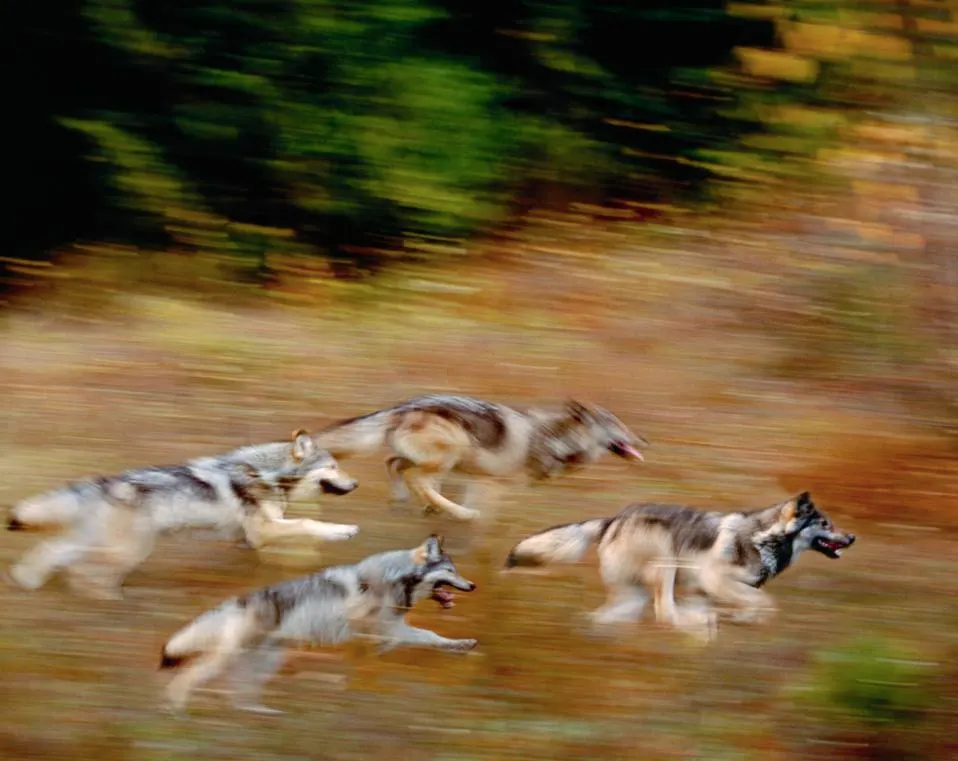


6 Officers and 79 Crew
201.1 ft
950 tonnes
Canadian Service 1940-1946
Germany began the war with 57 U-boats, but only 22 had the range for operations in the North Atlantic. Admiral Karl Dönitz of Germany's Kriegsmarine understood that a lone submarine, much like a lone wolf, had its limits.
In the wild, wolves hunt with a precision that is both brutal and
beautiful. They don’t rely on sheer strength alone. Instead, they work
as a team, communicating silently, reading each other’s moves and
attacking in perfect coordination.
Their strategy isn’t just about the kill—it’s about control,
deception and overwhelming their prey before it even knows what’s
happening. This deadly efficiency wasn’t lost on military minds. ~ Scott Travers - Evolutionary Biologist
Taking a cue from nature's playbook he instituted a pack-tactic early in the war. The Germans nicknamed their submarines graue Wölfe (grey wolves) and Rudeltaktik (wolfpack) when they hunted together in a pack. In 1940, two wolfpacks patrolled - one south of Ireland and the other west of Spain. Kreigsmarine expectations were high; the nine ships they sank were not nearly enough.
Donitz's wolfpack strategy materialized in May 1941, when Kriegsmarine finally had enough U-boats for coordinated operations at sea and those operations could be micromanage by from headquarters in France.
Gruppe West (Wolfpack group West), the first Rudeltaktik deployed to the North Atlantic, consisted of 23 U-boats. They began hunting on 8 May of 1941. Before West disbanded on 20 June after 43 days of hunting, the pack sank 33 ships and damaged several others. West one of the most successful wolfpacks of World War II.
Yet, it missed HX 129 and HX 130.

Enigma Machine
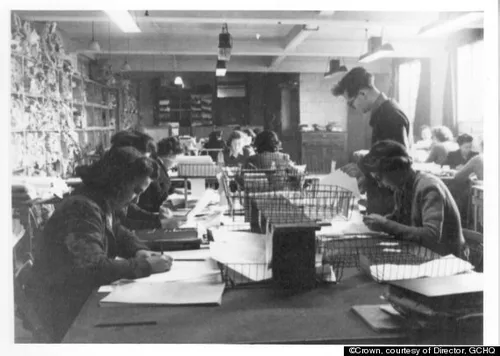
Bletchley Park Team
Through most of May the Kriegsmarine were able assemble wolfpacks and Wolfpack West prowled undetected.
At the time the Kriegsmaring Head
Quarters in Berlin relied on their Enigma machine and code to transmit and receive orders as well as co-ordinate the movements of their grey wolves. In 1941, the German navy had tactical advantage: control of the European Coastline, situational awareness and striking power. They building U-boats at an alarming rate and were close to reaching their goal of having 100 U-boats at sea at any one time. But, they did not know how quickly that advantage would change.
British Admiralty knew they had to break the naval Enigma code. The British codebreakers at Bletchley Park obtained bits an pieces of portable cipher machines and scrambler rotors. Eventually, they were capable of solving some of the German Army and Air Force communications. However, the puzzle of Kriegsmarine Enigma was much more difficult because the German Navy employed more secure procedures for using Enigma. One, the scrambler rotors were changed every two days, and two, cipher operators used code books to encipher a message and then it was enciphered a second time using a different code book.
Bletchley Park got lucky on May 9, 1941.
One submarine from Wolfpack West, had been damaged in a battle with two British warships. Under the belief that U-110 was fatally damaged, Commander Fritz Lemp ordered his crew to abandon ship. Fifteen of his crew were killed in action (he too died) and thirty-two were rescued by the British and taken away. The sub was damaged, but did not sink. The British proceeded to strip it of everything portable. A Royal Navy radio operator seeing things out of the ordinary and valuable in its radio room gathered charts, ciphers and codebooks. But most significantly, he had his hands on a complete and undamaged Kriegsmarine (naval) Enigma machine as well as Kriegsmarine's Kurzsignale (short signal code book). That May, Bletchley Park cryptologists broke the code for deciphering Kriegsmarine communications.
Seizing their opportunity for advantage, the British Admiralty initiated a plan of subterfuge. Realizing that the survivors could reveal that U-110 had not sunk immediately, the British isolated them at a POW camp at Iroquois Falls, Northern Ontario. To preserve the secrecy of its capture, the British navy towed the submarine from that area and deliberating scuttled it between Greenland and Iceland. Everyone was ordered not to reveal any details of the entire incident.
It was one of the best kept secrets of World War II, known as Operation Primrose. The British Military Intelligence MI6 called the intelligence from German encryptions Ultra, as in Ultra Secret. To add another level of security Military Intelligence created a a fictional MI6 master spy, in control of a fictional series of agents operating throughout Germany. The master spy's code name was Boniface which in turn was used as a cover name for Ultra. Also, the Admiralty decided to
let some attacks happen, even when they had the knowledge to stop them - just another layer of deception., security to conceal the fact they had broken the code.
This Ultra Intelligence enabled the Royal Navy to sink Germany's warship Bismarck west of France on 27 May and intercept the Kriegsmarine network of supply ships that were operating off Greenland to refuel and rearm Germany's heavy surface units and supply U-boats. Britain's deceptive tactics disrupted Wolfpack West's operation which resulted in fewer attacks on convoys in the latter part of May. In June, Western Approaches rerouted some convoys in a wider arc around Wolfpack West's position.
Still, the Royal Navy had not eliminated the possibility of a wolf-pack accessing the waters between Greenland and Iceland. In June, the first month of NEF operations, more than 454,000 tonnes of shipping were lost
to U-boats.
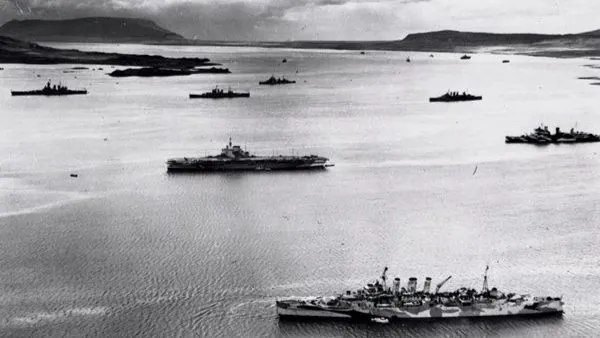
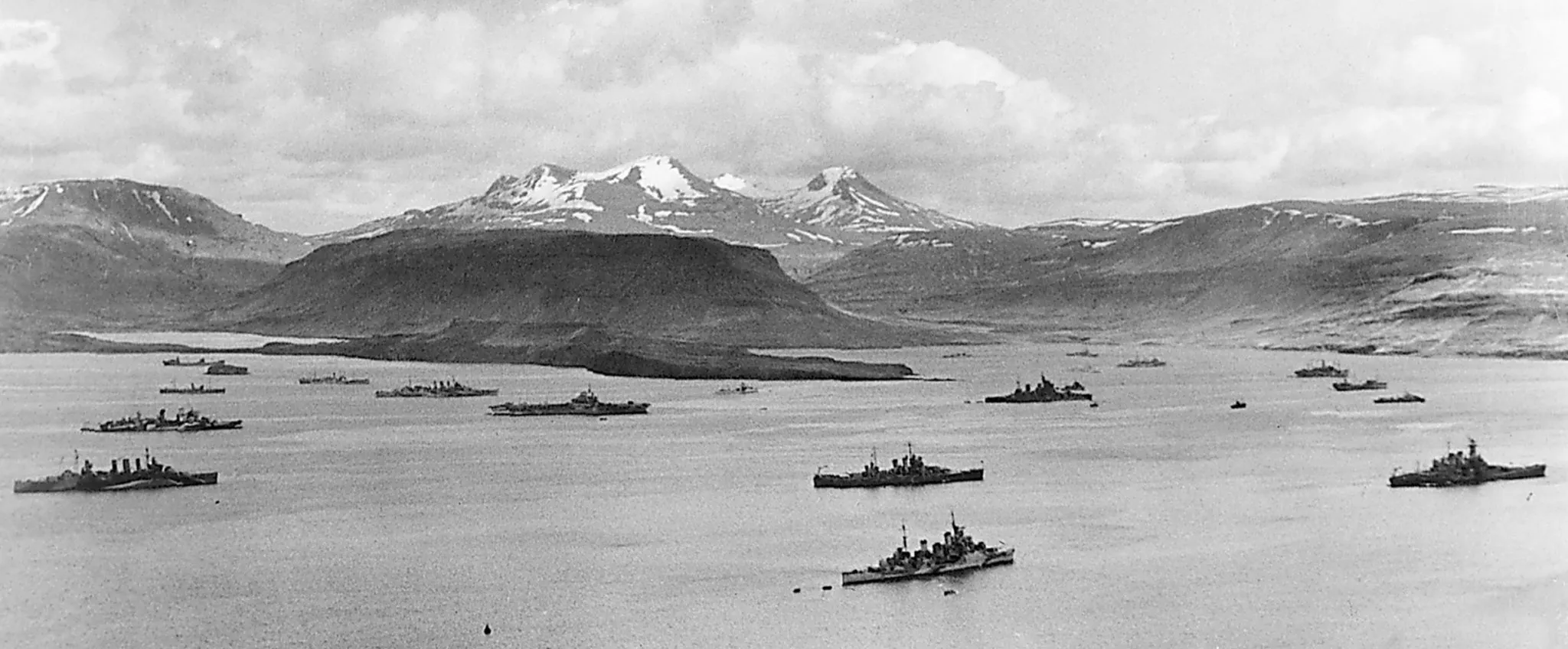
Location of Allied naval base at the bottom of the fjord, with deep anchorage for their warships.
By June 1941 the Nazi's escalated their attempts to invade the Soviet Union and it was obvious that any pact between Germany and the Soviet Union had dissolved. To resist the German war machine the Soviets formed an alliance with the Allies. The British Admiralty drew up a plan for a series of Arctic convoys to deliver
supplies and military equipment to the Soviet Union.
The Murmansk Run, a sea route along the coast of Nazi occupied Norway into the Barents Sea to Murmansk was the most dangerous convoy assignment of all.
Sailors had dubbed it the worst journey in the world or the Devil's Dance Floor. Polar lows created hurricane force winds, making stretches of open sea a nightmare. In winter months it was sub-zero temperatures and navigating the ice and rough seas. During war it was worse because Germans U-boats, with artillery and air support, targeted the sea routes from Iceland all the way to the ports of Murmansk or Arkhangelsk. In the summer months ships were exposed
to 24-hour daylight and more vulnerable to attack.
Every merchant seaman and navy crew on convoy duty, British and Canadian, prayed not to be assigned to the Murmansk Road.
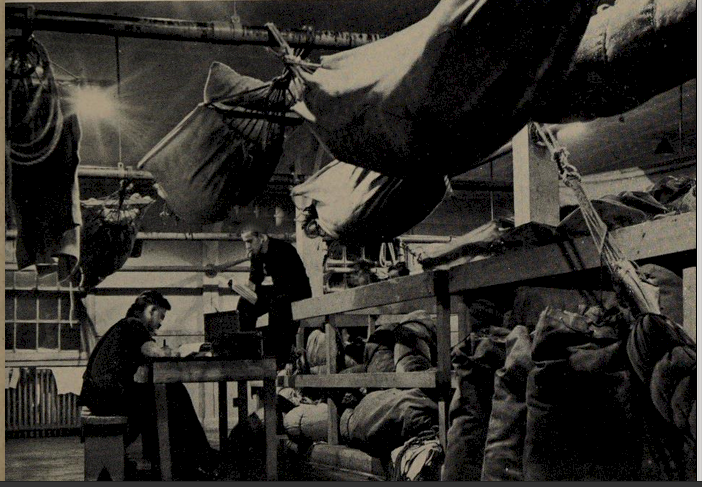
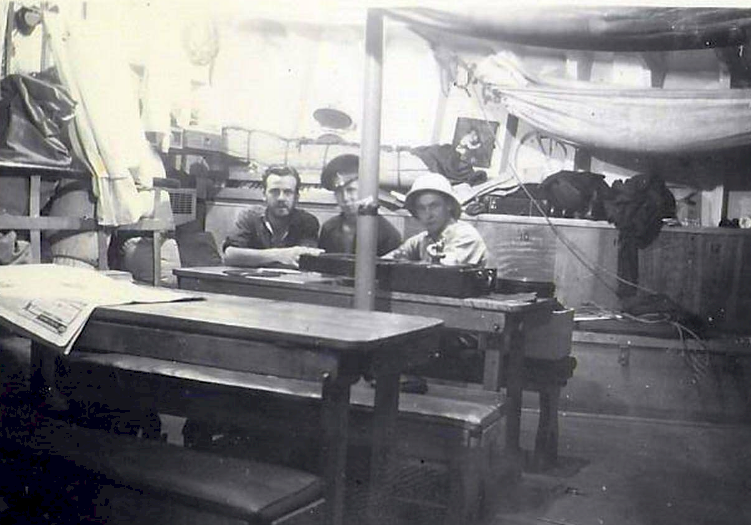
We can only imagine the intensity of that round trip through U-boat infested waters. Upon return, St. John's was a welcoming sight to the crew of HMCS Wetaskiwin.
Sailors welcomed shore leave when it was granted. War duties were demanding. Even when the enemy was not in sight, life aboard a warship was exhausting. It was even more exacting at the end of a stretch of diligent convoy duties aboard a Flower-class corvette.
HMSC Wetaskiwin was a cramped and uncomfortable vessel. In light of the pressing need for warships, the navy launched corvettes as quickly as humanly possible. There was little that could be modified in her short length and shallow draft to make the corvette a comfortable ship. It was intolerably crowded and living conditions on board for a crew of 70 sailors were terrible.
The original design for the corvette was based on trips of short duration and anticipation of accommodating a crew of less than thirty-five including officers and ratings. By the time the earliest corvettes were launched the crew size had already expanded to fifty-two men. In 1941, when the NEF was formed a corvette carried more than twice the number of men that was accommodated in the original design. Through the course of the war, as the complexity of the weapons changed on the ship, the number of specialists and support increased crew size to 85.
Living in a dormitory or barracks with a dozen other men was very different than sharing the confinements of a battleship with six or seven times that number. Each man aboard HMCS Wetaskiwin had to learn to cope with his circumstances and share living space with seventy-eight other men. Every man was expected to perform the jobs that were normally done on a ship that contributed to the well-being of the crew and general upkeep of the ship, be that cleaning or proper storage of food, water and other necessary provisions.
Being on the roiling sea for a fortnight or more was exasperating. Persistent
sea-sickness was the principal health-hazard. Young recruits were particularly prone to sea-sickness. Even experienced sailors could be overcome in really adverse conditions. Constant seasickness, left men retching and moaning for hours. Because they operated for extended periods in
close quarters, no one escaped it.
Physical hygiene was a challenge, since it was difficult to store enough fresh water for both consumption and and bathing. The sailors worked hard; they perspired, they were constantly exposed to the sun, wind and icy salt water. It was not unusual for the men to acquired a nasty rash.
The mess was organized with trap shelves that held cooking utensils in place and provisions were sealed in oak barrels. A ship could have an infestation of cockroaches which was a persistent problem on ship in this time.
Food was not scarce, but it was monotonous. The inability to store perishable food meant a reliance on preserved food. Perishable food was usually only available for the first two to three days at sea. After that, men ate servings of the only foods that were mould-free - canned corned-beef and powdered potatoes for breakfast, lunch and dinner every day. Sometimes they were fortunate to catch fish. Sailors could look forward to two daily treats, kye and grog. Kye was a hot sweet drink made of course chocolate, sugar and canned milk. Ratings over the age of twenty-one got grog, which was a 2.5 ounce ration of rum mixed with Coca-Cola or water.
Living conditions for officers were just barely reasonable. For seamen or ratings their mess deck was designed for eating, relaxing as well as sleeping. It was a tight, stuffy space. The men slept in canvas hammocks hung - sometimes three deep - from every conceivable spot on the deck head over their eating area. The mess deck was noisy and the atmosphere unhealthy, as these quotes from a few sailors attest.
-- A fortnight of rolling and pitching on North Atlantic convoy duty tended to exhaust all who sailed in them. Sleeping conditions for seamen were crowded, stuffy and quite often water-laden. The seamen’s messdeck was also full of smoke as most everyone in the mess was a smoker, so the only fresh air we got was when we were on watch in the open air.
--On a corvette three days at sea, anything that was breakable was broken. Riding in a corvette, working, recreation time, sleeping, etc., was extremely rough, noisy and dirty. The smell of the ship, and the men themselves, was absolutely gross. No laundry facility or showers. Fresh water was very limited. Hammocks were lashed (tied up) and stored during the day. Then at night hammocks were opened and I swear you could see blue haze rise from them. Stokers slept in their clothes, they merely removed their boots.
--Living on a corvette is not like a cruise ship. Hammocks are slung all over the seamen’s messdeck. Blankets are hanging out. Feet and legs hanging over the messdeck table you eat off. Washing at sea was next to impossible as we
made salt water into drinkable water, which was turned on back in the heads for a half-hour a day. Amazing that we never had too much sickness other than crabs and scabies, common in the navy.
--Personal hygiene was difficult and a salt water shower was an unsatisfactory experience. The soap(?) was a rock hard bar that produced no lather. When the salt dried on your skin, you felt dirtier than before.
--Sailors slept on lockers or tabletops or in any dark place that offered a little
warmth.
Basically, there was no privacy on HMCS Wetaskiwin, and certainly no peace and quiet. Day and night, sailors heard the near-surface cavitation sounds of the ship and the droning of the propellers, motors and gears. These sounds were background noise, almost pleasant, as compared to the loud acoustical sound of the winds and the loud crashing and banging of the waves hitting the hull as the corvette cut its way through the violent waves of the North Atlantic. Then there were days of gunnery practice when the thundering noise of the 4-inch Mk IX cannon and pom-poms were exploding.
There were two principle dangers, the sea and the enemy. The men on duty had to maintain constant vigilance. For long stretches of time what they did was repetitive. The tedium could be exacting and unbearable. But, men had to endure until shore-leave. Corvettes were at sea on escort duty for 29-31 days straight.
So going ashore was really always a treat. Strangely, one of the first adaptations to shore leave was adjusting to being on a stationary surface. The dock would initially feel like it was moving all over the place. But this would soon pass.
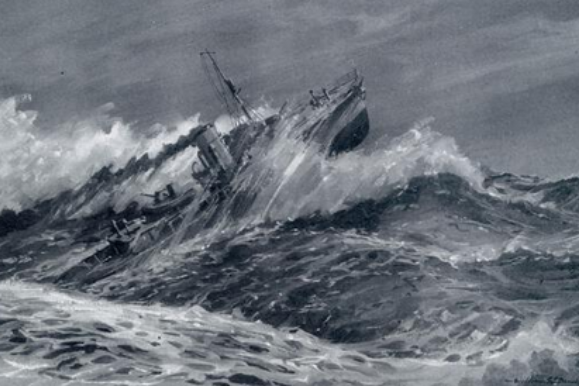
The Wetaskiwin was extremely uncomfortable when the sea got choppy. The North Atlantic is not a calm body of water.
HMCS Wetaskiwin was short and had a broad-beam. Basically, it was a warship designed for the tidal North Sea, which is notoriously treacherous for its shallow depths, shifting sandbanks and frequent storms. Most vessels found it difficult to withstand the violent swells of a storm surge and had to concentrate on staying afloat. The corvette, in the North Sea, could patrol in fierce weather despite the incredibly strong winds and closely-spaced waves.
However, its hull design made the ship behave very differently in the North Atlantic with its deeper water waves and hurricane-fueled storms.
A ship like a destroyer travels in basically a
straight line; they go through the wave, not ride it. Not the Corvette! They were very lively at sea.
The corvette would climb the wave then passing the top, the stem of the ship came crashing down on the other side. The sailors experienced an 80 degree roll, 40
degrees each side of upright. Crewmen suffered severe motion sickness until they acclimatized...during
the worst storms even the most hardened naval veterans felt uneasy for
sea-sickness.
Flower Class corvettes acquired the nickname pekingese of the ocean due to their pitch and roll. Newly built corvettes were modified to lessen the pitch and roll, but in early 1941 the Wetaskiwin's sailors had to learn to endure the discomfort of the cold and wetness.
Every dip of the forecastle
into an oncoming wave was followed by a cascade of water into the well deck
amidships. Men at action stations were drenched with
spray, and water entered living spaces... Interior decks were constantly wet and condensation dripped from the overheads.
They learned, too, that despite their poor sea-handling
characteristics, the Flower-Class Corvettes were exceptionally seaworthy. A corvette would not yield to the weather.
Lieutenant Harold G Chesterman, Captain of the corvette HMS Snowflake, said, Uncomfortable and lively and wet, but safe. No Allied sailor
was ever lost overboard from a Flower during World War II, outside
combat.
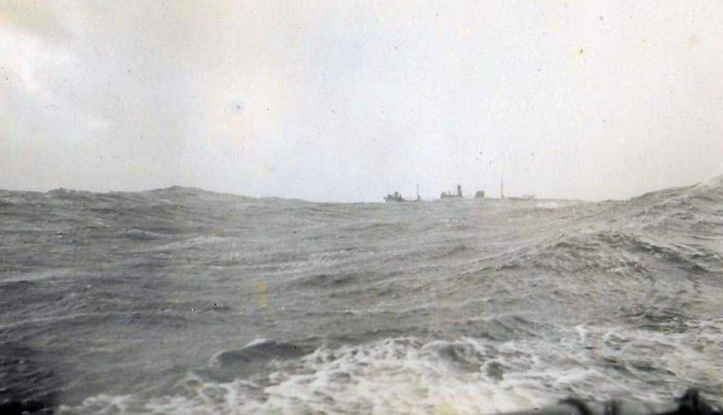
Early in the war convoys were large, usually consisted of about 60-150 vessels - container ships, grain carriers, freighters, tankers - all heavily loaded food and other necessities such as food, wheat, flour, molasses, fuel, oil, lumber, farm equipment, and trucks. Of course, it was wartime; troop ships and cargo ships carrying guns, ammunition, tanks and aircraft joined a convoy. With a shortage of warships, protecting that number of ships proved very difficult.
Keeping track of a convoy of ships while watching the depths for U-boats was challenging. We travelled in a zig-zag track to make it harder for U-boats to track us.
Imagine trying to co-ordinate the speed and zig-zag turns of 150 ships in a tight pack in radio silence
and blackout conditions at night, often in wild stormy weather. In comparison, herding cattle would be
child's play. Mostly we were successful but sometimes a corvette would have to round up strays. These
were very dangerous times because it broke up our defensive pattern and left part of the convoy exposed to attack.
And attack they did. The call to battle stations occurred quite frequently and the fight was on and it
was a violent, no holds barred, winner take all affair. loser, lost all.
HMCS Wetaskiwin escorted convoys that varied considerably in size, but on average most convoys numbered closer to 30 ships. The norm was to form up in six lines abreast, spaced around 500 yards apart. The five ships in each line spaced up
to one mile in front. Tankers and troop ships were placed in the middle. The faster, more survivable cargoes formed up on the flank, often referred to as coffin corner.
While a destroyer positioned its itself more distant, ready for a sudden attack on any
signal, a corvette, such as the Wetaskiwin, was trained to maintain a position close to the main convoy. Most convoys sailed at the slowest vessel’s speed. The average was 12 knots, which happened to be the corvette's ideal cruise speed. Still, it was not always easy for a corvette to maintain its position port or starboard, especially in fog and winter gales, on pitch black nights or through poor weather conditions.
It is aboard the the nimble Wetaskiwin - the corvette that did not just sail along as a deterrent - that the crew's job was to protect the ships. To do that the crew had to be continually scanning the open ocean for any sign of imminent danger. Sailors, both experienced and new recruits, risked their lives in the fog and winter gales.
By the high standards that might be expected in war, the corvettes may not have achieved an
acceptable level of competence, but in such an unforgiving sea, against the highly trained Kriegsmarine U-boats, it was the unwavering nerve of the crew that held HMCS Wetaskiwin in formation, vigilant, and prepared for battle.


It is on board corvettes, those small, sturdy and cheap vessels, that our Canadian sailors faced Germany’s formidable
U-boats during the worst months of the Battle of the Atlantic.
Under James Douglas Prentice, the Wetaskiwin crew had learned how to scout or hunt for U-boats as well as protect the ships.
However, those ultimately in charge at Western Approaches Command and the British Admiralty, prioritized the safe and timely arrival of convoys. Orders made it clear that escorts
were to prioritize evasion to ensure the convoy's safety, but
also had a duty to destroy enemy ships when possible without
compromising the convoy.
In training, Prentice had impressed upon the Corvette crews that Kriegsmarine subs were elusive, but they couldn't hide forever. At some point, a U-boat had to eventually surface. In fact, for most
of the war, U-boats were effectively surface ships that could submerge. The U-boat was designed
to be quiet and stealthy, but spinning propellers emitted sounds and powerful diesel engines were loud. Above and below water, the sub's machinery emitted an acoustic signature that could be
detected from a distance.
HMCS Wetaskiwin lacked sophisticated radar, good visual signaling equipment, radiotelephones, and even a good telescope to read flag signals. What she had was an alert crew. Lookouts above decks were positioned to be hypervigilant with sharp eyes on the sea and ears listening to the sounds of the ocean to identify a U-boat's distinctness or spot the track of a torpedo which was quite visible. Below decks, specialist ASDIC operators listened for the drumming of the U-boat's machinery, the flow noise, the cavitation bubbles off its propeller, the creaking of the hull when the sub changed depths, and that distinct echo pattern of the sonar pings that bounced off the hull.
Under Prentice, the Wetaskiwin crew had learned how to implement the quick attack. It was an aggressive course of action - running directly at the submarine as soon as it was sighted. Though the Wetaskiwin could cruise along at 12 knots she could muster up 16 knots in a hurry. That hard-hitting tactic forced a sub to dive which crippled its speed and manoeuverability.
The Wetaskiwin's greatest battle advantage was her
turning circle, the tightest of all Allied warships. It could out-manoeuver a U-boat and pin it down in the depths by passing back and forth over the submarine's position. The quick attack included firing the Wetaskiwin's top-side guns and the launching of depth charges or Hedgehog mortars.
Once a U-boat was spotted or detected, the Wetaskiwin know how to act swiftly, and to do so she employed the combined skills of her crew. They not only had to get a fix on the target they had to consider the movement and proximity of all ships in the convoy.
Any of Wetaskiwin's weapons could be dangerous to other ships in proximity especially if the sub had crept into the heart of the convoy. Also, the crew had to consider that the blast from a 4-inch BL Mk.IX would leave the Wetaskiwin crew temporarily night-blind which might allow the U-boat to escape. Then there was precision of using depth charges. The depth charge, once launched, sank to a preset depth where water pressure triggered the fuze, setting off the explosives. To destroy or damage a submarine, this tactic required precise targeting. But, even an utter miss still produced an explosion which created a powerful shockwave. By mixing the weight of the charges and the order of their firing, the Wetaskiwin could create a three-dimensional explosion around the submarine and hope to crush its hull with the shock wave. The shock wave could also affect merchant ships if they were close to the explosion.
Scouting U-boats was a grueling and hazardous cat and mouse game taking place in the rough North Atlantic. Every day, 24-hours per day, for 29-31 days straight, the crew had to be on high alert against the relentless and numerically superior U-boat. Shadowing a U-boat could put the men on the Wetaskiwin on edge because they could fall prey to the U-boat they were hunting, but their staunch courage held strong. Still, in the vast Atlantic catching sight of a surfaced U-Boat that had not already been disabled by depth charges was a rare sight. Canadian
sailors rarely saw the elusive submarines that stalked the convoys.
Early in the war, British corvettes were equipped with advanced ASDICS (sonar) as well gyrocompasses and radar. Whereas, Canadian corvettes only had access to the more primitive ASDICS technology and a magnetic compass. ASDICS provided the location of the sub by using bearing and sound. The compass provided directional information. The corvette could be right above a U-boat and the ASDICs failed to penetrate the complex water layers. Sometimes the tracking technology of the ASDICS were inadequate due to the accuracy of the magnetic compass. Even with the specifics of its predetermined deviation factored in, the magnetic compass could be imprecise because the pounding of the sea or exploding weapons could alter the magnetism of the ship. When this occurred the crew of the Wetaskiwin often had to resort to making educated guesses when plotting an attack.
Skirmishes between a corvette, bobbing on the sea, and U-boat below, were quite common. It was a quick hard-hitting approach that either disabled the sub or drove the submarine deeper. Meanwhile the convoy escaped out of range.
The more effective Hedgehog spigot mortars came into use in 1943. It was a forward-throwing weapon that fired up to 24 spigot mortars ahead of a ship. The projectiles traveled through the water at 7 meters per second. Within 9 seconds, the crew knew they had hit a submerged U-boat hiding 60 meters below because the mortar exploded on contact. A Hedgehog miss was eerily quiet and discouraging.
Actions against a U-boat demanded considerable seamanship skills from all the crew. Frustrating too because, once spotted, the corvette had slightly poorer speed than a U-boat's 17 knots. It was successful at remotely detecting or tracking the sub, but could not properly chase it. Then of course, afterward the corvette could have difficulty catching up with the convoy.
In 1943 the Kriesmarine were better able to evade counterattack when they began using technology of the Falke acoustic torpedoes. U-boat captains did not have to use the periscope to release the homing device and subs had a better chance to remain below depths undetected. This put Canadian warships and convoys at more risk.
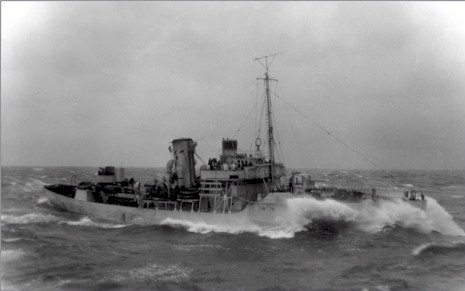

6 Officers and 79 Crew
201.1 ft
950 tonnes
Canadian Service 1940-1946
Wetaskiwin escorting three convoys without a major incident in July, HMCS Wetaskiwin.
On 27 August, Kriegsmarine ordered Gruppe Markgraf - a wolfpack 15 U-boats - to patrol south-west of Iceland.
The Wetaskiwin was deployed on 29 August to escort HX 147 to MOMP. That convoy also arrived safely, despite the presence of a wolfpack patrol in the area.
The Royal Navy had interpreted those Kriegsmarine orders. Western Approaches Command rerouted HX 147 and five other convoys around the concentration of U-boats. Finding no convoy, the wolfpack was ordered to widen their patrol line. Again, the Royal Navy decoded the orders and directed convoys ON 12, HX 148, SC 43 and SC 42 to divert course and make a much wider detour. However, the Allies did not actually know the exact positions of the U-boats.
Three convoys made the detour. However, SC 42 became trapped by a storm and the ice barrier which left the convoy of 65 ships exposed to detection. The NEF escort consisted of only 4 warships: River-class destroyer HMCS Skeena and 3 Flower-class corvettes, Alberni, Kenogami and Orillia.
On 9 September, U-85 spotted the convoy and fired a torpedo, but missed. Following wolfpack tactics, U-85 shadowed the convoy while other Markgraf subs closed in. When the moon rose to silhouette the ships, Markgraf attacked.
U-432 torpedoed the freighter, Muneric. It was loaded with 7,000 ton of iron ore and sank rapidly taking her crew of 63 souls to their deaths. U-432 was still on the surface when HMSC Kenogami commenced firing. However, in the flash of gunfire, the crew lost sight of the their night vision as well as the sub. The convoy commenced emergency turns to evade the U-boats, but Markgraf the convoy was attacked, including the Canadian destroyer, Skeena. The torpedo aimed at Skeena missed, but four freighters were sunk and tanker Tahchee was damaged. Another emergency turn gained the convoy two hours of respite - suspenseful quiet. In that time, warship HMCS Orillia got the damaged tanker under tow and was able to search astern of the convoy for survivors on their way back to port.
Orillia's departure left 3 Allied warships to protect SC 42. Despite several emergency turns the convoy could not escape Gruppe Markgraf. Kreigmarine reported:
U-85 attacks at once but has no success. Other boats come up and attack at night. U-81, U-82 and U-432 sink one ship each, U-652 damages two ships, one of which is finished off by U-372 and the other is towed back by the Orillia. U-82 misses the Skeena.
During the 10th, U-432 is the contact keeper. U-85 attacks twice by day, sinking one ship, but is herself also damaged by the Skeena and Alberni. U-501 is pressed under water by a Catalina and is then sunk by the corvettes Moosejaw and Chambly, sent as a reinforcement.
In the night, the U-boats press home their attacks: U-202 has no success but U-82 sinks three ships and damages one, U-432 and U-433 sink one each, U-207 sinks two and finally U-202 finishes off the ship damaged by U-82.
Convoy SC 42 needed reinforcements. HMCS Wetaskiwin handed off escort of HX 147 to the Royal Navy escort on 8 September. After refueling in Iceland Wetaskwin along with two British corvettes and a navy trawler was ordered to reinforce protection of SC 42. They were joined by 5 British destroyers from Convoy ON 13.
Near Iceland HMCS Chambly under Prentice was conducting training exercises with newly commissioned HMCS Moose Jaw when they were dispatched to reinforce the escort of SC 42. On 10 September, in the Denmark Strait between Iceland and Greenland, the two corvettes had just sailed through a severe storm, when Chambly's ASDIC operator detected a U-boat.
Both corvettes made a depth charge run at the sub. As U-501 surfaced, Moose Jaw was charging to ram it. U-501 turned at the last moment and suddenly the sub was running parallel to the corvette. The commander of U-501 leaped some 9 feet from his boat and onto the deck of HMCS Moosejaw without even getting his feet wet! This, while his crew scuttled the sub. Moose Jaw commander did not know this, nor did he know the extent of the damage to the U-boat. After all, the submarine was still moving and his job was to disable it.
Moose Jaw veered to open range enough to make the turn and ram the sub with full force. A nine-man party from the Chambly got on board the U-501 in an attempt to seize secret papers, but the submarine sank under their feet. (One Canadian sailor and eleven German sailors perished.) U-501 was the first U-boat sunk by Canadian escorts.
There were reports of several U-boat periscope sightings that day, but SC 42, marshaled across several kilometers of sea, was up against a submerged and outstretched wolfpack of at least twelve other U-boats. Freighters worked feverishly to rescue survivors and catch up with their convoy which was taking evasive measures. Still that night of 10 September, Gruppe Markgraf sank eight more ships.
Wetaskiwin's late morning arrival to help Convoy SC 42 on the 11th followed that of Moose Jaw and Chambly. Their daylight arrivals coincided with RAF protection from the airbase in Iceland.
When night fell, the RAF was gone. Only Wetaskiwin and other warships remained for protection. The wolfpack was lurking.
Kriegmarine further reported:
U-207 is sunk by the Veteran and Leamington, U-652 makes an unsuccessful attack and U-105 sinks an independent. U-432 is the contact-keeper.
In the night, the escorts keep the wolfpack at bay. Only U-43 and U-84
fire but both miss. The following days some boats remain in contact but
the strong air and sea escort, heavy seas and bad visibility make it
impossible to attack. On the 14th the newly arrived U-552 is the last to have contact before the operation is broken off.
Between the 11th and 14th the Allies dispatched more reinforcements from HX 147 and convoy SC41. The presence of more warships and daytime air cover allowed the original escort vessels to depart for refueling. Though Gruppe Markgraf continued to stalk the convoy, the wolfpack was stifled from mounting another assault. Convoy SC 42 arrived in Liverpool on 20 September.
Gruppe Markgraf sank 16 ships (68,259 tons) and damaged 4 ships (14,132 tons). Between 15 August and 15 September Kriegsmarine commanded four additional wolfpacks in the waters of the North Atlantic: Grönland (21 boats) Kurfürst (7) Bosemüller (8) Seewolf (17) and Brandenburg (11)
HMCS Wetaskiwin's survived its first direct encounter with U-boats.
After refueling a warship assigned to NEF could be deployed to defend a convoy in the vicinity of Iceland or relieve other warships that needed refueling before escorting a convoy back to the WOMP. On the 20th Wetaskiwin was back at MOMP with destroyer HMCS Skeena and corvettes Orillia and Rimouski to pick up Convoy ON 016. That duty ended 26 September.

German U-Boat

German U-boat riding the surface.
Wetaskiwin's spent the next six days in St. John's in more training and some down time. Her next deployment was set for 9 October to escort a slow moving SC convoy.
Tucked into the northeast shore of Cape Breton Island in Nova Scotia, ten-mile-long Sydney Harbour was where most of the slow moving convoys assembled. On 5 October, 52 ships, most loaded with critical war materials, formed up as Convoy SC 48 and sailed from the harbour. The weather forecast was good.
Instead of heading to the Grand Banks to meet the NEF escort, the convoy was routed through the Belle Isle Strait. As a whole, the vessels proceeded at an average speed of 5.6 knots, lower than the expected average. From St. Johns, HMS Gladiolus joined the convoy on 8 October and Canadian destroyer HMCS Columbia and 4 corvettes HMCS Wetaskiiwn, HMCS Camrose, HMCS Rosthern and Free French corvette FFL Mimosa took up escort positions the next day. At this point three corvettes from Sydney remained with the escorts: HMCS Shediac, HMCS Baddeck and HMS Gladiolus.
That night the weather deteriorated. Three ships lost their way. On the 10th Columbia, Camrose and Rosthern left the convoy to search for them. HMCS Shediac also got separated by the storm and was out of radio contact.
Mordbrenner (arsonist) was a pack of four U-boats patrolling the MOMP. On 10 October three more U-boats were ordered to move in and Kriegsmarine had six additional submarines enroute from their base in France. Allied intelligence became aware of the presence of Mordbrenner and diverted the convoys that were then at sea to get around the wolfpack patrol line. SC 48 was diverted to the south-east.
In the turbulent weather several ships had difficulty steering. More ships strayed from the convoy formation. In total, ten merchant ships, three corvettes and the destroyer Columbia were not only detached from the convoy they were out of contact when the convoy changed course.
On the night of the 12th Allied Ultra intelligence failed to intercept Axis Enigma messages which left the convoy exposed, and in disarray with four ships missing and eleven ships straggling. HMCS Rosthern, while searching for HMCS Shediac, got lost. HMCS Shediac was unable to regain contact and on 13 October decided to head for Iceland.
The command ship HMCS Columbia had not yet returned to the convoy. Following procedural orders, command of convoy protection passed to the senior officer (SoE) among all escort vessels. Lt Cdr G.S. Windeyer, HMCS Wetaskiwin, took command. SC 48 only had the Wetaskiwin and three other corvettes as escort. Seven submarines were closing in.
Just before daylight on 15 October, U-553 sighted the convoy. Realizing the convoy only had four corvettes as protection, U-553 initiated an attack before calling for the wolfpack to close in. The U-boat got ahead of the convoy and surface between columns to fire five torpedoes at four different ships, before being spotted. Three torpedoes missed - the input data was incorrect - but two ships sank. Just as U-533 was crossing the column to to fire on another vessel, one of the tankers in the convoy tried to ram it. U-553 dodged the tanker and then outdistanced two corvettes. The sub's commander notified Kriegsmarine he had contact with a convoy. The corvettes searched but U-553 remained out of range until mid afternoon about the same time that Columbia finally caught up to the convoy.
Taking the offensive, Columbia forced the U-boat down and attacked with depth charges. Two hours later, U-553, still operational, fired a torpedo at Columbia. The destroyer avoided the trajectory. In a counter attack Columbia finally damaged U-553, but it remained seaworthy, and evasive.
The sub continued to shadow the convoy and sent bearing signals to lead Mordbrenner to the convoy. Kriegsmarine ordered four more U-boats to be in position within 24 hours to attack SC-48 from the north and the south. Due to rough seas the rest of the wolfpack was delayed, but remained on course.
That same day, Allied intelligence had again obtained decoded Enigma dispatches and learned that Mordbrenner was closing in. The Commander in Chief of Western Approaches deployed the NEF's relief escort earlier than planned and diverted a task Unit of warships from other convoys that were beyond the wolfpack's reach. Reinforcements included two destroyers from a troop convoy and five destroyers from a United States naval squadron. None of those reinforcements were expected to arrive until the next afternoon. The convoy undertook rigorous evasive measures.
Mordbrenner attacked during the night. U-568 fired three torpedoes at the starboard wing of the convoy and sank a steamer. Two corvettes moved to attack the sub. They fired star shells to illuminate the area but U-568 escaped detection. Other U-boats advanced for an attack, but were impeded by a deluge of heavy rain and poor visibility. By noon three U-boats had again spotted the convoy. But, before Mordbrenner engaged, the US Naval Squadron appeared and actually passed over U-568, but did not detect or notice the sub's presence.
Command of convoy protection passed to the senior office on the USS Plunkett. The convoy escorts commenced several coordinated sweeps but the U-boats evaded by crash diving or heading directly into rain squalls. Towards evening at least two Allied aircraft, flying at maximum range, were on the scene. The aircraft dropped bombs on one U-boat. Four other U-boars were forced to hide and lost contact with the convoy. The aircraft disappeared. All the while, U-553 managed to remain hidden and resumed shadowing the convoy for the next four to five hours.
Just before midnight on the 16th, U-553 penetrated the convoy escort by passing the lead destroyer at only 150 meters distance and found herself between the
escorts on the port side and the port wing of the convoy. At this time the escort consisted of five destroyers (one Canadian and four American) and four corvettes (one British, one Free French and two Canadian) HMCS Wetaskiwin was still one of the escorts.
U-boat
553 fired four torpedoes at tankers. While the first three likely missed by running too deep, the fourth
torpedo, intended for a tanker, hit the British corvette, HMS Gladiolus. HMCS Wetaskiwin was the last ship in radio contact with the British corvette HMS Gladiolus before she was lost with all hands.
USS Kearny pursued U-553 and fired star shells to illuminate the area. Once again, U-553 evaded. Due to Kearny's proximity to the convoy, the star shells illuminated the merchants ships, making them more visible to the rest of the wolf-pack.
An hour or so later at 01.15 hours, Mordbrenner launched a series of attacks on Convoy SC-48 starting with U-558
attacking the outermost column on the
starboard side. U-558's first torpedo missed but hit
another ship beyond. U-558 sank 3 merchant ships before going after one of the largest ships in the convoy, the tanker Barfonn. After it was hit by U558, Barfonn stayed afloat. U-432 fired a coup de grace at 04.48 hours. The hit ignited the fuel oil
carried by the tanker, which exploded and illuminated the whole area
astern of the convoy. The light exposed U-boats and merchant ships.
Mordbrenner sank merchant ships W.C. Teagle, Erviken, Bold Venture, Evros, and Barfonn. U-568 torpedoed the American destroyer USS Kearny. The explosion killed eleven men and wounded 22 others, eight of them seriously. However, the destroyer did not sink. The crew managed to regain power and slowly made its way to Iceland under escort.
During the night, reinforcements arrived to help in the rescue of survivors and chasing U-boats. HMS Highlander and HMCS Wetaskiwin were on the hunt but found no contact. The last attack of the night was at 7:27, again by U-558, which
missed a straggler with its final torpedoes. (U-558 was under the command of Günther Krech, one of Kriegsmarine's top U-boat aces. In 10 patrols he sank 17 merchant ships and one allied war ship and damaged several others.)
In the midst of the hunt the commander of HMS Highlander became SoE which
led to some confusion among the escorts as they were not all aware that
this change of command had occurred.
At dawn the SoE tried to reform the escorts around convoy SC-48, which
now consisted of 31 ships, but the convoy was in complete disarray. The Wetaskiwin and most of the corvettes lagged behind the convoy because they were carrying out rescue operations.
Even after the arrival of air cover and additional escorts, Mordbrenner continued to track different columns of the convoy. But, could not mount an attack because two U-boats were out of torpedoes and the others were not near enough. The night of the 18/19 was calm, but during the day a gale hit the convoy. Several ships, including escorts were damaged and the convoy was scattered.
Kriegsmarine Command disbanded the the 13 U-boats of Gruppe Mordbrenner. Those that had torpedoes and fuel formed up with wolfpack Reissewolf.
On 25/26 October 'Ultra' intelligence suggested that there were four
U-boats off the Belle Isle Strait and up to 20 in the central part of
the North Atlantic.

Image Credit: International Churchill Society - All Right Reserved
Mordbrenner torpedoed and sank 10 merchant vessels and 2 warships.
In retrospect, Convoy SC-48
experienced significant losses due to a combination of equipment
failures, inexperienced command, and tactical errors. Many escorts had
non-operational radar or ASDIC, hindering U-boat detection. Inexperienced US Navy commanders stayed too close to the convoy,
accidentally aiding U-boat attacks by illuminating merchant ships. Surface U-boat attacks made the escorts' depth charge tactics
ineffective. To further exacerbate coordination problems among the escorts it was later determined that the radio transmitters of the US warships
interfered with the British sets. Therefore, British and Canadian ships would have received intermittent or no communications about the change of command or directions of protective or defensive measures, making proper coordination between the
escorts impossible.
Survival in the icy North Atlantic is critically dependent on immediate action. In the midst of battle HMCS Wetaskiwin was able to save 24 survivors of the torpedoed merchant ship Barfonn. Those survivors remained with the Wetaskiwin during the remainder of her escort duties and were later delivered safely to Iceland.
That was not the only battle that the Wetaskiwin and her crew faced that winter on the North Atlantic.
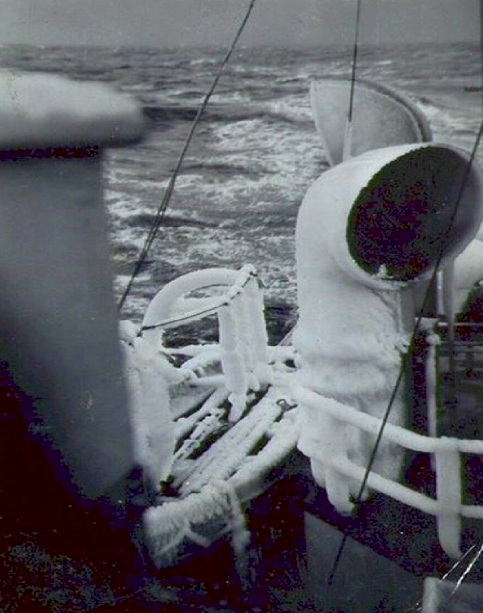
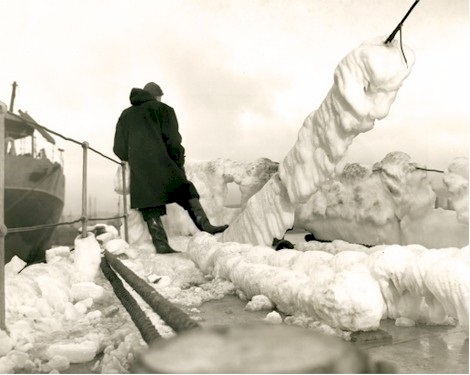

U-boats on the hunt, a wolfpack lurking and ready to close in - that was not the only danger in 1941.
The North Atlantic was notorious for
its rapidly changing weather, strong winds, dense fog, storms, pitch black nights, ice and vicious surface currents. Navigating the Wetaskiwin in any of those condition was challenging and hazardous.
Because of the design of the corvette with its short fo’c’sle there was nothing to prevent sheets of water from crashing down on the deck. Imagine the sheer volume and weight of the water that washed over the deck with each successive wave. They were wet ships.
When air temperatures dipped below zero the icy cold sea spray instantly froze upon contact with the Wetaskiwin's hull and superstructure. Sheets of nautical icing also formed from freezing rain, drizzle, fog, or the cold waves washing over the vessel. The most dangerous icing occurred when the strong winds generated more than the normal sea spray. Ice built up rapidly and the weight of that ice could alter the ship's centre of gravity, reduced its stability and affect speed and maneouverability. Since the corvette was prone to pitching and rolling the accumulation of ice was a significant hazard on a choppy sea.
On the open sea there was nowhere to take shelter and a warship on duty could not alter course; the crew often had to use axes, shovels, and mallets to remove ice.
“All hands on deck to chip ice.”
The ship
was pitching and rolling through huge waves. Spray was soaking everything, as
high even as our mast-head, and, as it landed on the surface, it froze. A
thick, and growing, layer of ice was adding tons of weight where it was most
dangerous. We would roll to one side so far it would seem the mast must hit the
water and we would turn upside – goodbye good ship Wetaskiwin and all your
crew. In that water, life expectancy
would be a few minutes at most. But each time we would hang there for what
seemed like a long time then slowly start to roll the other way. Meantime we chipped ice as though our life
depended on it and it probably did. Chipping ice was unfortunately all too
common
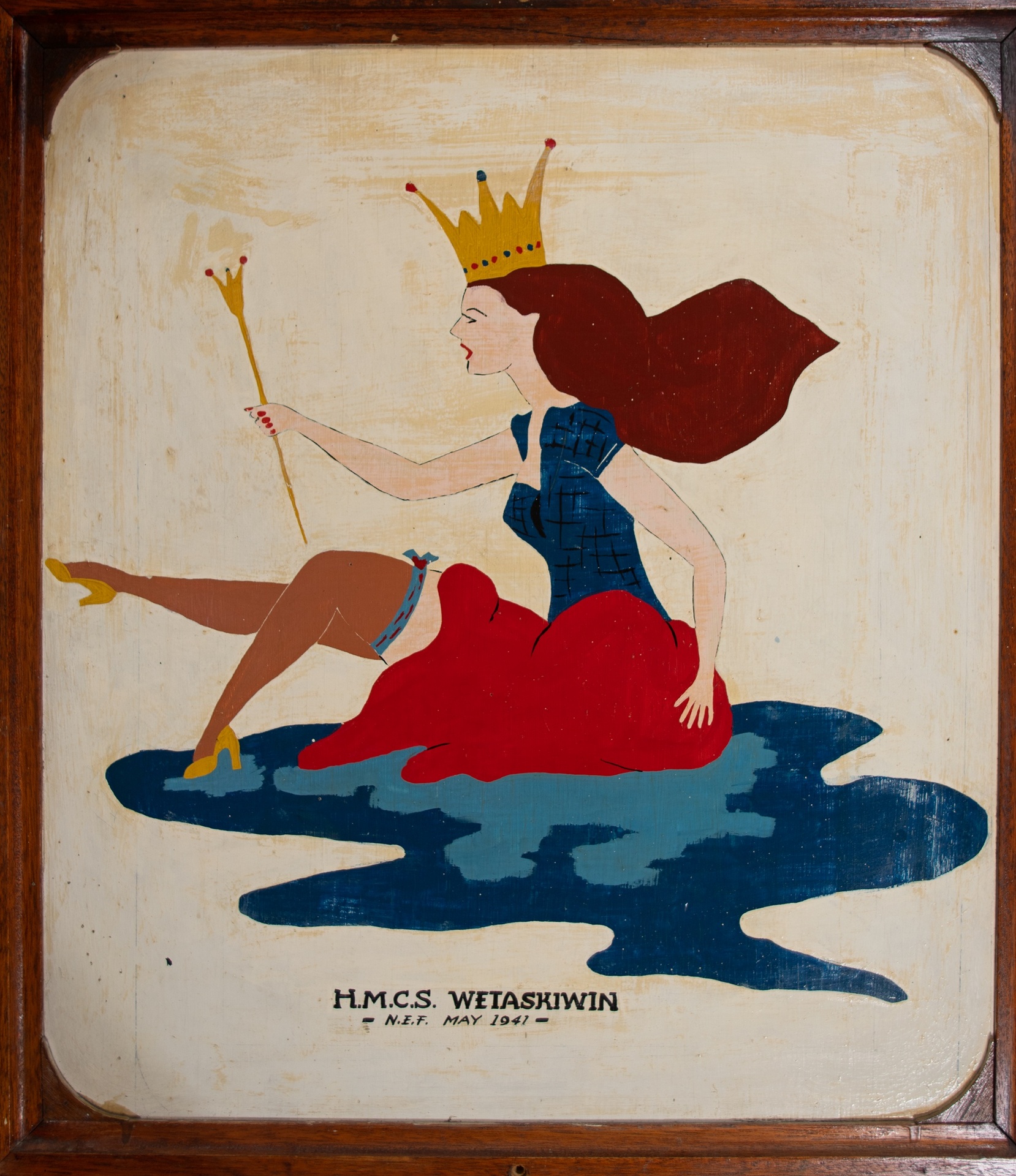
Photo of Original Gun Shield placed in Crow's Nest, St. John's in January 1942

Bernie Forbes - 1944 crew member & artist

HMCS Wetaskiwin's Guns
The Wetaskiwin was a Wet Ship
In the open Atlantic, the notoriously heavy sea broke over a corvette. Salty water seeped in through every available opening - seams, hatches and ventilators. When the weather was bad, water was everywhere.
Every dip of the forecastle into an oncoming wave was followed by a cascade of water into the well deck amidships. Men at action stations were drenched with spray, and water entered living
spaces. Men could not leave their mess without
getting drenched.
The almost constant ingress of water made it nearly impossible for the crew of the Wetaskiwin to stay dry. Their cramped accommodations were consistently damp and cold - a real menace.
The Queen of Hearts
Individual ships had their own nickname. HMCS Wetaskiwin had two. One was politely used - Queen of Hearts. (See newspaper article). The other moniker was her more affectionate nickname, well known on both sides of the Atlantic.
Ships in the Royal Canadian Navy did not have official insignias.
The commanding officer of a ship was permitted
to devise and pay for his own ships badge, under the knowledge that it would come
under the scrutiny of higher command. The
policy of the Insignia Committee further decreed that the insignia should not
contain anything offensive to propriety or good taste (references to the enemy
excepted) and that badges should not be regarded as official.
Ships had their own insignia visibly displayed on the ship's gun shield or bridge structure. Most took the form of cartoon characters and artists, from amidst the crews, produced truly amazing insignias. Wetaskiwin's was genuinely distinguishing.
A talented artist from the crew had found the perfect canvas on the wardroom bulkhead adjacent to the officers' living quarters for the playing card, Queen of Hearts. The queen was a comely gal, head crowned and sceptre in hand, falling bottom first into a puddle of sea water. As an armorial bearing it was a reasonable representation of her less comfortable moniker. By pronouncing the last two
syllables of Wetaskiwin as queen, one thus articulated Wet Ass Queen. The crew had affectionately dubbed HMCS Wetaskiwin as such early in the war.
It was whimsical, light-hearted and based on the sailors experiences. Water made its way into every compartment.
--Interior decks were constantly wet
and condensation dripped from the overheads. The head (or sanitary toilet) was drained by a straight
pipe to the ocean; and a reverse flow of the icy North Atlantic would cleanse the backside of those
using it during rough weather.
--There was discomfort in using the heads (toilets) at sea. While the ship rolled, one was likely to be flushed by a backlash of water which the toilet
traps could not stop.
In early 1942, the originally painted gun shield depicting Queen of Hearts from the Wetaskiwin, was placed on the wall of the newly formed officers club, The Crows Nest, on the upper floor of a warehouse in St. John's. (It was the first of many gun shields to be placed on the walls of the club and has a place of honor today. See More Another painting, a mural version of Wet Ass Queen adorns a wall of Legion 86.)
Due to the elements - or when the ship was refitted - that five by seven foot painting had to be touched up or repainted several times and one of the crew members always stepped up with a brush. Eventually, Bernie Forbes (photo above) was entrusted with the job. Forbes had been a commercial artist prior to service. He is quoted as saying:
I was responsible for keeping her perky and with every repaint or retouch-up, I couldn’t resist lifting her skirt a little and increasing her bust one size larger.
The Queen of Hearts sitting in her puddle was a unique identifier among the fleet and a source of pride for her crew.
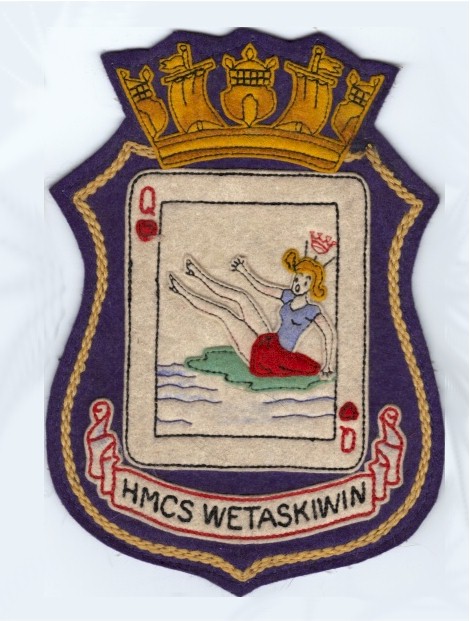
Badge from WW2 Melton Jacket
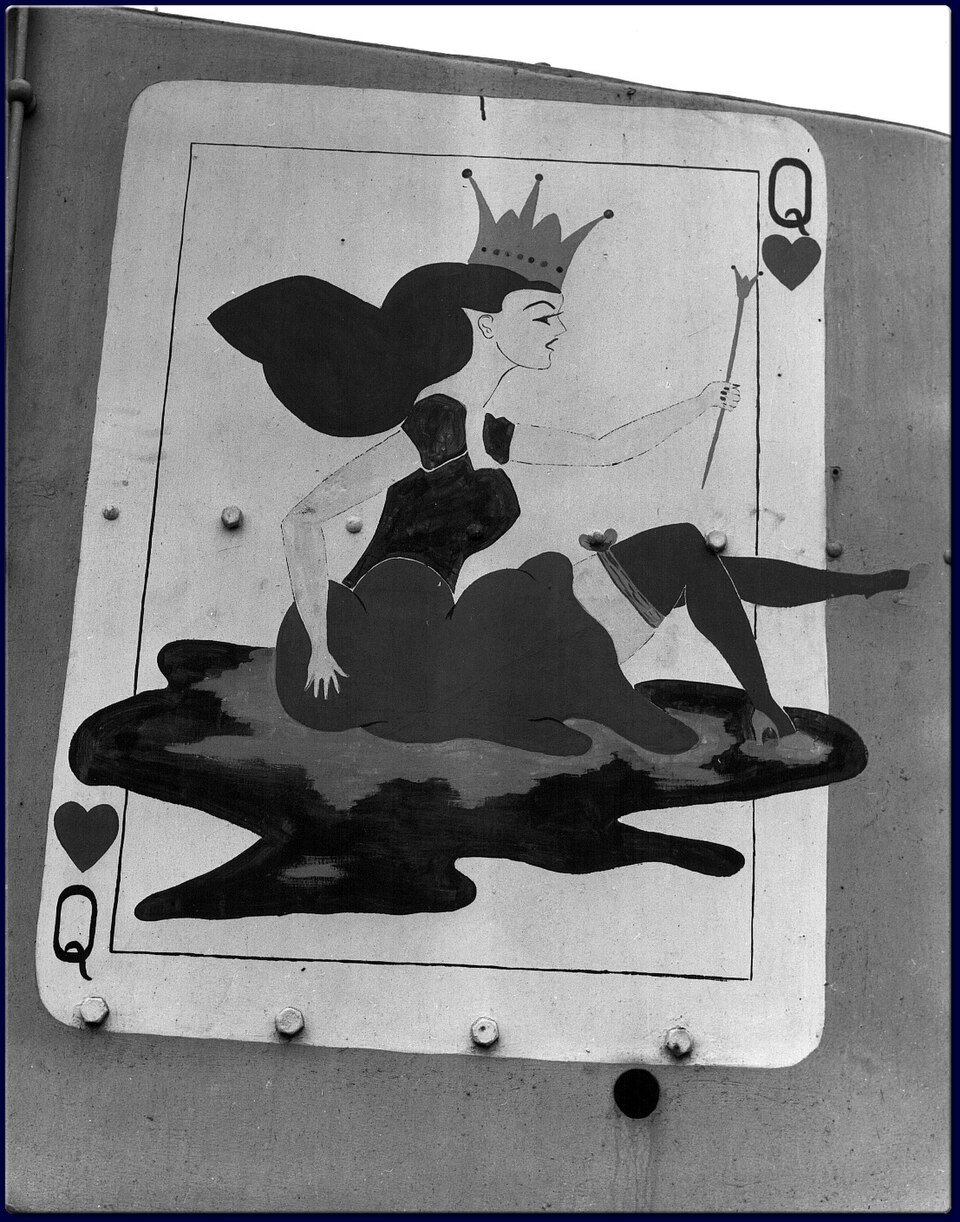
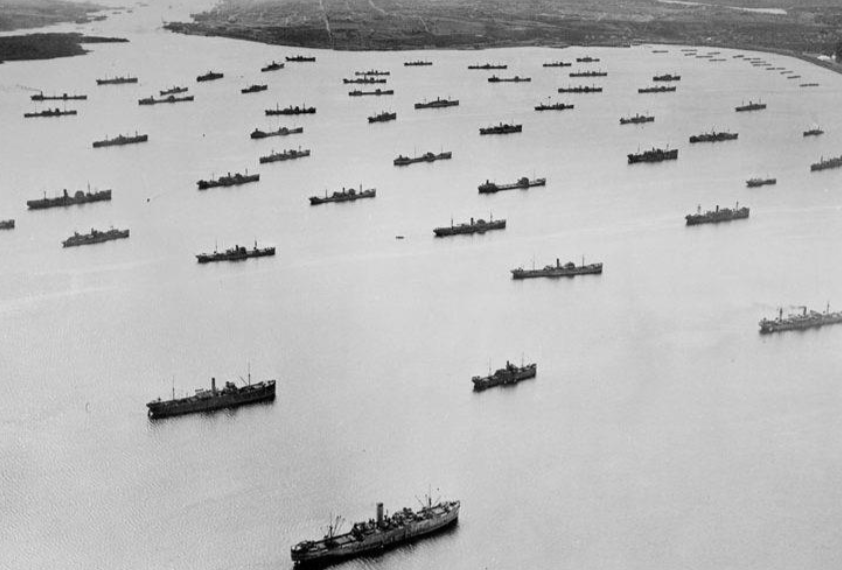


Photo: Imperial War Museum A-8953
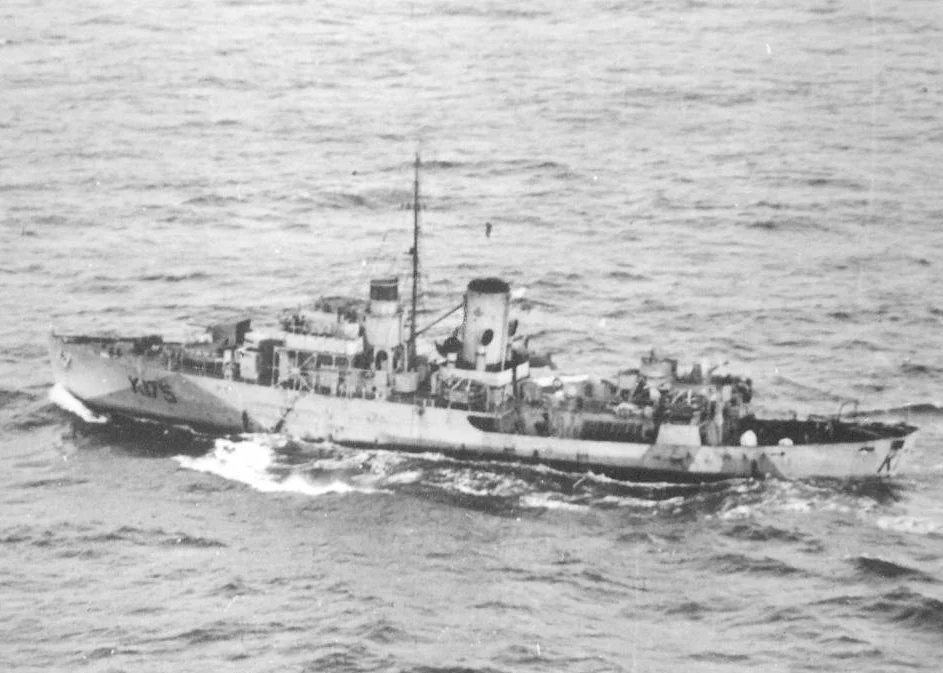
The Wetaskiwin had to weather the storms, the pitch black nights and the ice and function within a system that was far from perfect. The support for the convoys
was not anywhere near sufficient for the task at hand.
The NEF and RCN escort groups protected a larger percentage of slower eastbound convoys (14 out of 24) while on balance the Royal Navy was usually assigned to faster HX convoys. In dangerous areas the slower convoys were more easily intercepted and vulnerable to German Kriegsmarine attack.
In 1941, the Royal Canadian Navy had few resources, inadequate technology, and a lack of properly equipped and trained vessels rotating through the command. Communications remained a major impediment and the RCN lacked experienced escort group commanders. Under orders of Western Approaches Command and the British Admiralty, there was very little the Royal Canadian Navy could do to improve the quality and efficiency of the NEF or Canadian escort groups. The hurdles were due to over-commitment of the RCN to operations in support of its allies.
The NEF often sailed with one destroyer and used the few corvettes they had as the mainstay of convoy protection. Vessels damaged by a ravaging sea or combat delayed refit schedules and were less seaworthy or capable which put the convoys as well as navy personnel at greater risk.
During the month of October Royal Canadian Navy vessels were averaging 28 out of every 31 days at sea and NEF's operational cycle between Newfoundland and Iceland was unbearable as winter set in. To ease the strain in mid-October, every ocean-going escort of the Royal Canadian Navy was deployed to the NEF. With little reserve force to augment personnel, by the end of 1941 senior officers warned that:
...men and ships were being tested beyond their limits, with too little and
inadequate equipment, insufficient training, and too little time to recover
from the horrors they frequently witnessed as ships were blown apart and
survivors froze to death within minutes in the frigid north Atlantic.
Admiral Murray stated:
Conditions were terrible that winter. Groups worked on a 35-day cycle
which entailed 29 days away from St John's, 27 days away from fresh
bread, 25 days away from fresh meat, added to which at the northern end
of their beat there was no sunlight to speak of in the winter. We had to
revert to the old rations of Nelson's time, barreled salt beef with
lime juice or tomato juice to scare away scurvy.
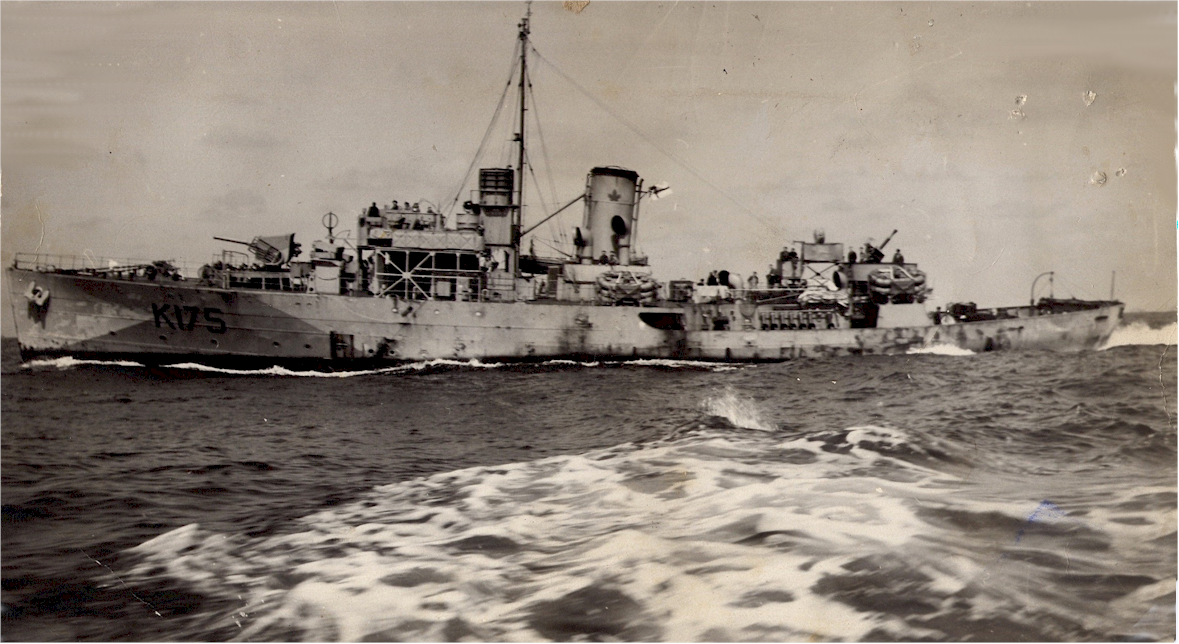
HMCS Wetaskiwin looking a bit beaten up by the sea and convoy duty.

6 Officers and 79 Crew
201.1 ft
950 tonnes
Canadian Service 1940-1946
By January 1942 HMCS Wetaskiwin made six round trips between St. John's and Iceland. The warship was sent to Halifax. She was do for a refit which was part of a routine maintenance cycle.
K175, battered by the sea and ice sailed into Liverpool, Nova Scotia in February and was put into dry-dock.
The
sea was a brutal operational factor for World War II warships,
necessitating frequent refits. The constant exposure to harsh marine
environments caused significant structural strain,
leading to metal fatigue and wear on hulls during continuous operations
in rough seas with hurricane force winds. Furthermore, saltwater induced severe corrosion and fouling, requiring regular maintenance, cleaning, and repainting of the hulls to prevent rust and maintain efficiency.
Beyond the hull, heavy seas caused equipment damage,
affecting everything from sensitive machinery and gun mounts. Flooding in lower
compartments and ventilation intakes could compromise the ship's stability, machinery, and electrical systems.
These environmental factors, combined with
combat damage and the need for technological upgrades, meant that regular refits were essential to maintain the
structural integrity and operational readiness of naval fleets during
the war. Beyond physical damage, refits were crucial for restocking supplies,
refueling, and general maintenance to sustain the high level of
deployment required by a global war.
Modification on the Wetaskiwin included removal of unneeded minesweeping gear, installation of surface radar, and increased capacity for depth charges. The galley was relocated to a more central, midships position to improve habitability.
Wetaskiwin would be crewed again in May for work-ups and operational readiness before officially returning to officially to service and to the icy North Atlantic. When she returned it would be to join the C-3 Escort group of the Mid-Ocean Escort Force
(MOEF), an amalgamation of the NEF and British-based escorts.

6 Officers and 79 Crew
201.1 ft
950 tonnes
Canadian Service 1940-1946


British Intelligence knew that the Kriegsmarine had U-boats patrolling off the coast of Newfoundland near Belle Isle Strait in October 1941. U-boats appeared off Nova Scotia's coast in January, 1942.
In January 1942, Kriegsmarine launched Operation Drumbeat (Unternehmen Paukenschlag or Beat of a Kettle Drum). Germany command wanted to act fast to deliver a swift crippling blow to the Allied supply lines by sinking as much merchant shipping as possible. Three factors favoured German success. First, the Allies convoy escorts were stretched thin. Second, Germany could exploit the fact that west bound convoys were routinely dispersed at sea on the Grand Bank and traveled without escort to Canadian and American ports. Third, the United States was unprepared for naval warfare on its own shores. Germany's U-boat fleet would meet little resistance on the North American coastal waters.
At least eight U-boats arrived off the coasts of Nova Scotia and Newfoundland in January. Drumbeat's first offensive was sinking the steamer Cyclops south of Halifax on January 12. In the next two weeks, U-boats torpedoed ten ships - nine unescorted - between Sable Island and St.
John’s. In February, they sank five more.
In response to German submarine activity in Canadian waters, the Royal Canadian Navy formed the Western Local Escort Force (WLEF). Based in Halifax, the WLEF operated short-range escort duties, taking convoys from
Halifax to the Western Ocean Meeting Point (WOMP)
off Newfoundland.
The Royal Canadian Navy had limited resources for home defense and used old destroyers and Bangor-class minesweepers to protect the ships.
The RCN was still gathering its resources and manpower and certainly not prepared for an inshore attack when U-553 sailed up the St. Lawrence River to target ships from Montreal carrying critical supplies. On the night of 11 May U553 torpedoed and sank the British freighter SS Nicoya off the Gaspé Peninsula between Gaspé
and Anticosti Island, and a few hours later sank the Dutch freighter SS Leto in the same area. The Battle of the St. Lawrence had begun.
Despite
efforts by the Royal Canadian Navy to establish convoy systems and a
local escort force to operate on the St. Lawrence, U-boats continued their successful campaign sinking 2 Canadian warships and another 22 merchant vessels before 9 September when the St. Lawrence was officially closed.
U-boats continued to penetrate Canadian waters. The sinking of the SS Caribou in the Cabot Strait on 14 October with the loss of 31 crew and 136 passengers, was considered the worst inshore disaster of the battle.

6 Officers and 79 Crew
201.1 ft
950 tonnes
Canadian Service 1940-1946
After her refit in Liverpool, Nova Scotia, K175 slid back into the cold water. Her light grey paint and pale camouflage scheme blended into the foggy overcast North Atlantic. Structurally, she looked largely the same. Lieutenant Commander Guy Stanley Windeyer returned to take her through her work-ups.
To ensure the vessel and crew (some of them new ratings) were fully operational and ready for deployment, K175 went through a month sea trials and system testing to ensure that the engines, steering, navigation, electrical system, and propulsion were all functioning correctly and that the crew were battle-ready.
The Wetaskiwin joined the Mid-Ocean Escort Force (MOEF) in late May 1942. She was assigned to Escort Group C-3 which at that time included: Canadian River-class destroyers Saguenay and Skeena with three other Flower-class corvettes Sackville, Galt and Camrose.
Basically, the NEF was renamed and restructured into the MOEF, expanding the duties of the NEF by providing continuous straight-through escort across the entire Atlantic, from North America
to the Western Approaches of Britain. Iceland functioned more as a strategic base rather than a relay point. The MOEF convoy system allowed convoys to
use more direct, southerly routes, which was more efficient for merchant
shipping.
MOEF was formed after the United States entered the war and Kriegsmarine launched Operation Drumbeat. Escort groups were designated as A (American-led Escort Group), B (British-led Escort Group) or C (Canadian-led Escort Group). When
the MOEF was established, an American admiral, based in Argentia,
Newfoundland had operational control over the western Atlantic
theatre.
Initially, the MOEF consisted of 14 escort groups. Each group worked in a 33-day cycle allowing nine and one-half days with a westbound ON convoy, six days in St. John's, Newfoundland and Labrador, nine and one-half days with an eastbound HX or SC convoy, and eight days' refit in Derry. Each group was theoretically composed of a full complement of warships,
though in practice, the actual number of available ships fluctuated due
to maintenance needs, battle damage, and transfers. The total force was
intended to have over sixty units available at any given time, but often
operated with fewer, around 50.
Primarily these were Canadian ships as soon after the formation of the MOEF, US Navy ships were
withdrawn from the North Atlantic to meet commitments in the Pacific and Mediterranean. Though the United States withdrew from direct escort duties, it retained operational command. Canadian MOEF convoy escort remained under American operational command out of Argentia until April 1943. By that time the Royal Canadian Navy had taken on the majority of the crucial mid-ocean
escort duties and did so for the remainder of the war.
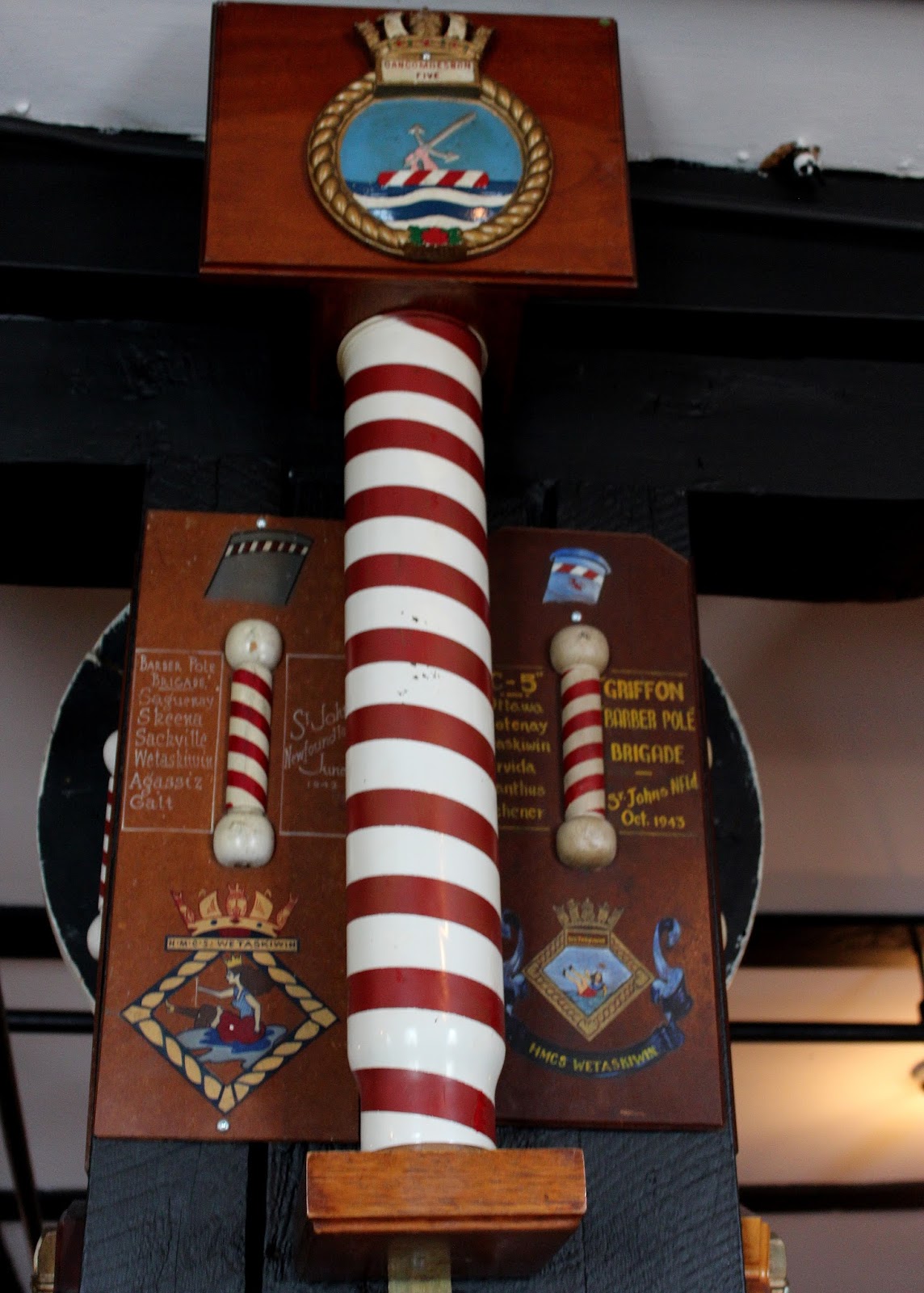
The Barber Pole Brigade's display in the Crow's Nest, St. John's

C-3
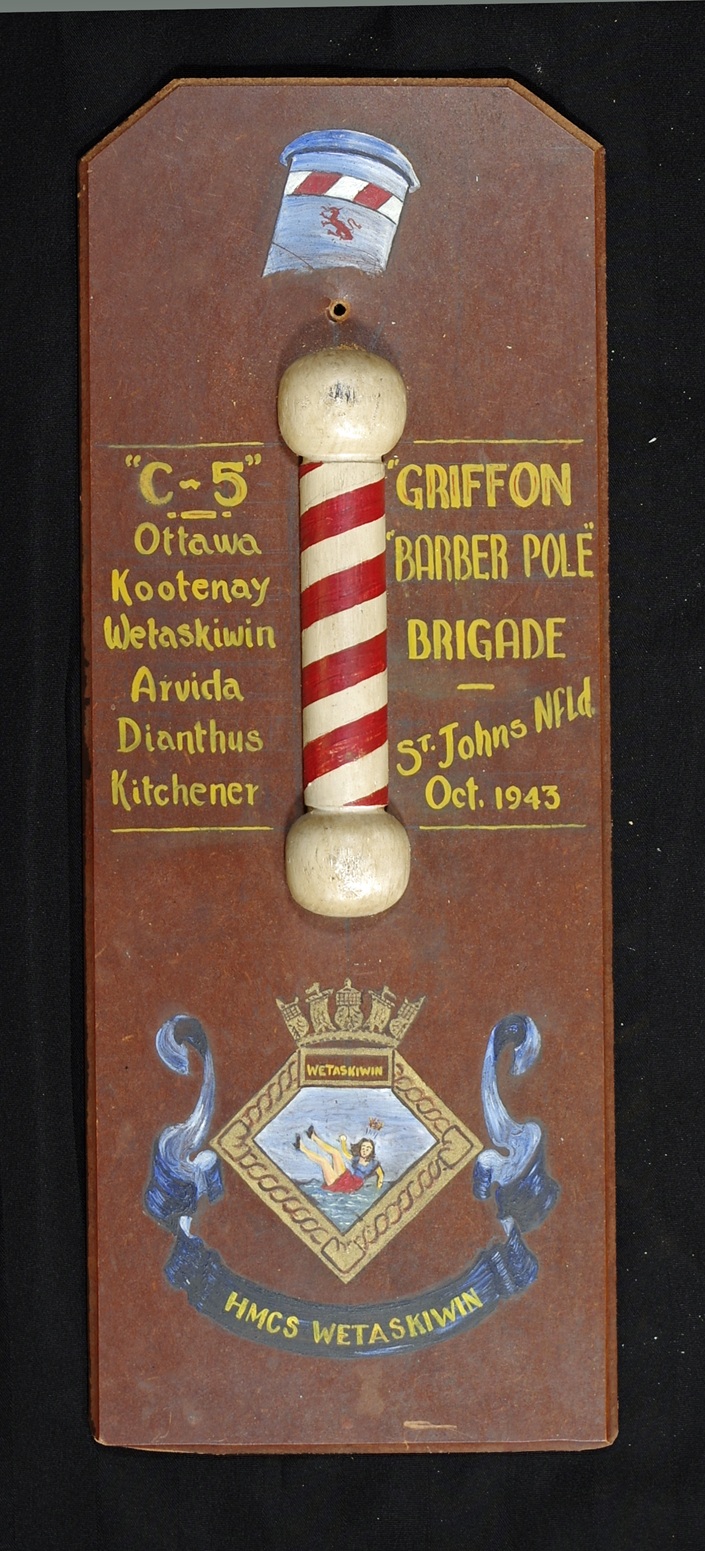
C-5
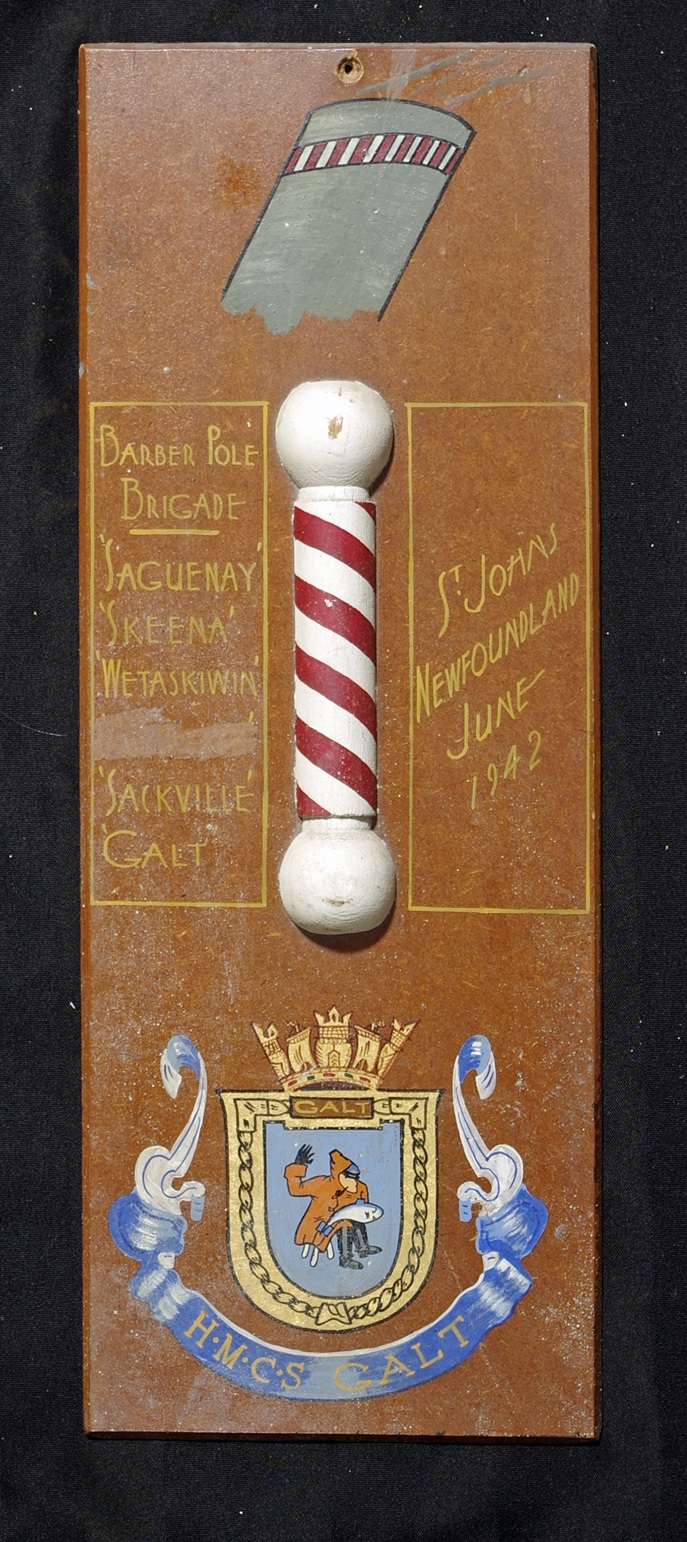
C-3 with stripes in opposite diagonal direction
Third Canadian Escort Group (C-3) of the Mid-Ocean Escort Force included two destroyers HMCS Saguenay and HMCS Skeena, and four corvettes HMCS Sackville, HMCS Wetaskiwin, HMCS Galt, and HMCS Agassiz.
One June day 1942, the commanders of C-3 were in the Crows Nest Officers Club when it was suggested that the group needed an insignia that would permit instant recognition. Lieutenant Kenneth Dyer's from HMCS Skeena offered that his first lieutenant had suggested that a band of diagonal red and white
stripes be painted around their funnels like a barber pole. The commanders agreed, then and there, to adopt that insignia.
The crews were enthusiastic and soon their smokestacks displayed their version of a barber pole. Rather than the whole funnel, they painted a narrow band near the top. The
insignia became a source of pride and tradition. C-3 quickly became known as the Barber Pole Brigade. The insignia inspired an officer to write a song
about the group that was shared among the ships' crews.
In early 1943, the RCN's mid-ocean escort groups, including C-3, were
temporarily withdrawn from the North Atlantic run and sent to British
waters to receive essential upgrades in technology and equipment (such
as radar, HF/DF, and improved depth charge throwers) and for refit. They
were then engaged on the demanding UK-Gibraltar convoy routes before
returning to the North Atlantic battle in April.
A new group C-5 was formed (sometimes referred to as the Fifth Escort Group). Its Senior
Officer Admiral Ken Dyer decided to adopt the established and popular
barber pole emblem to quickly foster group identity and cohesion,
especially appropriate since a number of former C-3 ships and captains were part of
the new C-5 group. (Chummy Prentice was part of this group.) The spirit and challenges of serving in the group even inspired a song, The Barber Pole Song, written by a medical officer while aboard HMCS Kitchener in 1943.
The Barber Pole Brigade and holds a
significant place in the history of the Royal Canadian Navy's role in
the critical Battle of the Atlantic. C-3 became one of the most successful convoy escort groups in that period.
The tradition endured. The barber pole was later revived in the Royal Canadian Navy for the Fifth Canadian
Escort Squadron in 1958. Today, all commissioned ships in the
Canadian Atlantic Fleet continue to wear the barber pole mark on their
funnels or masts as a proud tribute to the wartime heritage and bravery
of this specific escort group.
HMCS Wetaskiwin was with C3 and C5 and remained with the Barber Pole Brigade until late 1944 when she transferred to the Western Local Escort Force (WLEF) for coastal defense duties.
In St. Johns, the officers needed a safe
environment, to get know each other, to build trust and confidence in each
other. The venue to foster that
relationship was a club called the Crows Nest was a loft in a warehouse. The men climbed 59 steps up to a place where
they could get to know each other.
There are four memorial plaques for C-3 in the Crow’s Nest Officers’ Club in St. John’s, Newfoundland. Two are dated June 1942 and two dated October 1942. Of the three depicted in the photos above, note that the one on the left has stripes in the opposite direction to the other two. Like Wetaskiwin's funnel being painted differently than the other ship in the Barber Shop Brigade the individual ships had different painters who probably did not have a pattern to follow.

The Barber Pole insignia on the funnel of K175
In January 1942, fourteen days into her first patrol German submarine U-588 sank the British steamer Caledonian Monarch northwest of the Outer Hebrides. On March 1st during her second patrol, U-588 was 840 km southeast of Halifax when she torpedoed the Caperby another British cargo ship. Nine days later a Gulf Oil Corporation ship, Gulftrade, carrying 80,ooo gallon of oil was less then 10 km off the northern tip of Long Beach Island, New Jersey when U-588 fired a torpedo that cut the tanker in half.
U-588's third patrol in early May brought the submarine closer to Canadian shores. It was foggy in the early hours of 9 May. Sixteen kilometers from Halifax Harbour, U-588 fired three torpedoes at the US freighter, Greylock. A sailor on sea watch spotted the torpedoes but not in time for any real evasive action. Fortunately two torpedoes missed. The third damaged the stern, but quick action by the crew enabled the ship to reach the safety of Halifax. The next day U588 torpedoes and sank the Kitty's Brook, a Canadian steamer, 56 km southeast of Cape Sable, Nova Scotia. The U-boat's torpedoes were accurate again on 17 May when they sank the Norwegian Steamer SS Skottland near Yarmouth, Nova Scotia.
Lurking in the same vicinity, on the moonless night of the 18th, U-588 attacked the British merchant ship Fort Binger with two torpedoes. Somehow, in the jet black sky, lookouts spotted the torpedo tracks streaking toward the port bow. The ship turned hard to port and the first torpedo missed by a mere 20 meters. The second torpedo glanced off the port bow, but did not explode. Like from page of Prentice's quick action playbook, the Fort Binger went on the offensive and tried to ram the submarine and successfully drove it off, but U-588 surfaced again a few minutes later and opened fire with deck guns. The Fort Binger, armed with a stern gun and machine guns, returned fire and again tried to ram the sub, but could not work up a good head of steam. Fortunately, that aggressive action gave the steam ship time to escaped in the fog to Yarmouth where they anchored and got help for those wounded by the gunfire.
U-588 headed south. On 22 May, the sub appeared again off the US coast where it chased the US steamship Plow City northward for four hours before firing two torpedoes to sink it about 200 miles off Cape May, New Jersey. Continuing north towards Nantucket U-588 torpedoed and sank Margo, another British cargo ship headed to the Suez Canal.
Patrol number four began 19 July. U-588 left her base in France and turned up in waters east north-east off St. John's Newfoundland.


Convoy ON 115 was a westbound convoy of 41 ships sailing from Great
Britain to North America, escorted by the Canadian Escort Group C3, which
included the destroyers HMCS Saguenay and HMCS Skeena, and the corvettes HMCS Agassiz, Galt, Louisburg, Sackville, and Wetaskiwin.
Two Wolfpacks, Pirat and Wolf, were trying to track down Convoy ON 115. On 28/29 U-210 sighted the convoy and vectored in the other subs. Six enemy subs moved into position to pursue and attack.
Shadowing every turn made by the convoy, the U-boats advanced on the
30th and 31st but Canadian Escort C-3, the Barber Pole Brigade, was able to repulse those attacks and prevent the subs
from engaging for a mass attack. Using a different tactic, Kriegsmarine
command ordered six U-boats from Wolfpack Pirat (13 U-boats) to form a patrol
line directly across the path of ON 115.
In the early hours 31 July, HMS Skeena and HMS Wetaskiwin were
defending the convoy’s starboard flank when Skeena spotted the diesel exhaust
of a submarine, eight miles off the convoy’s starboard beam.
Skeena alerted Wetaskiwin with
the signal Acts 16, Verse 9 which told the corvette: And a vision appeared
to Paul in the night; there stood a man of Macedonia and prayed him saying,
come over into Macedonia and help me.
This signal was part of a coding system used by the Royal Canadian Navy
during World War II, where Bible verses were used to quickly and
securely convey specific operational messages related to enemy sightings
and attacks. The signal Acts 16, Verse 9 specifically meant, I have
sighted a submarine; come and assist me immediately.
Wetaskiwin responded with Revelations 13, Verse 1 which told the destroyer: And I stood upon the sand of the sea and saw a beast rise up out of the sea
having seven heads and ten horns, and upon his horns ten crowns, and upon his
head the name of blasphemy. Decoded the Wetaskiwin replied: I have the U-boat on my sensors and moving to engage.
The two warships altered course towards the submarine and prepared to attack.
The first Canadian attack
drove the submarine deep. Skeena coordinated a search, and within an
hour, the two ships regained SONAR contact with the enemy. Over the next few
hours, the Canadian escorts executed a textbook anti-submarine action: one ship
held the contact while the other ship maneuvered to attack.
In total, Wetaskiwin
deployed four patterns of depth charges, and Skeena attacked twice.
Finally, their patience and proficiency was rewarded with the sound of two
distinct underwater explosions, thirty seconds apart, followed by the
appearance of oil, floating debris, and human remains on the ocean’s surface. Skeena followed up the sighting with a signal that she was lowering a whaler to pick up guts, which translated into I'm putting a boat in the water to collect
evidence of the destruction.
The four-hour chase had taken Wetaskiwin and Skeena a significant distance away from the convoy. After the sinking of U-588, HMCS Skeena proceeded to St. John's. High speed and sustained tactical manoeuvring drained her fuel supply. A few hours later the Canadian destroyer Saguenay detached from the convoy and also headed to St. John's for the same reason. HMCS
Wetaskiwin zeroed in on relocating the convoy.
Though the Barber Pole Brigade had successfully sunk the notorious U-588 five enemy subs of Pirat still shadowed the merchants ships of convoy ON 115 and another wolfpack was dispatched to help. Pirat formed a line to intercept the convoy and 7 U-boars from wolf pack Wolf move in for a concerted attack on 2 August. About the same time the U-boars arrive on the scene Canadian reinforcements arrived from St. John's. Wetaskiwin's fuel supply reached its limit and she headed for port. The Canadian corvettes were able to thwart four U-boat attacks but still, three merchant ships went down and two were damaged.
Pirat, directly across ON 115’s path
When the Battle of the Atlantic moved to the North
American seaboard German U-boats were attacking sinking from Halifax
to the Caribbean and into the Gulf of St. Lawrence. More than 200 tankers were
sunk very close to the Canadian and American shores. In addition to surface escorts for convoys to England, the Royal Canadian
Navy pivoted to protect south bound convoys, too. The Navy had 188 ships and 16,000 men
at sea. The
RCAF had eight maritime squadrons and 78 aircraft to carry out increasing
surveillance of the northwest Atlantic.
By wars end of the 123 corvettes that served in the RCN, ten
were lost to enemy action. Upwards of 72,000 sailors, soldiers, merchant seamen, and airmen lost their lives on the side of the Allies. 3500 Allied merchant vessels, 175 warships, and 741 aircraft were destroyed. Civilian casualties are unknown; more than 30,000 German sailors were killed.
Ships and cargo and lives may have been lost over the course of the war. However, the measurement of success for the Royal Canadian Navy, for the Flower-Class Corvettes, and their commanders and crews, should not be in the number of U-boats sunk. Rather it should measured in terms of tonnage protected and lives saved. More than 25,000 merchant ships safely made
it to their destination under Canadian escort and that resulted in the delivery at least 165
million tons of vitally-needed supplies to Europe.
Battle for Convoy SC 109 18 November 1942
The Brilliant, an American tanker was hit by U-43. the torpedo opened a hole about 40 feet in diameter in the side. All crew members survived. Due to the quick action of some crew members, the ship did not sink right and made it to Newfoundland. Later while towing it back to home port, gale winds and rough seas broker her in two. The forepart sank taking eleven men with her. The other 44 men on the remaining part were rescued.
Battle for Convoy HX 233 - 17 April, 1943
54 Ships departed from New York 6 April 1943 and arrived Liverpool on 21 April Escorted by American Coast Guard cutters Spencer and Duane, Canadian destroyer Skeena, Canadian corvettes Wetaskiwin and Arvida, English corvettes Dianthus, Bergamot and Bryono. Eight U-boats from an unnamed wolfpack patrolled for 4 days. Only one ship Fort Rampart, on her maiden voyage was torpedoed. Six crew members were lost. The master, 40 crew members, six gunners and three passengers (DBS) were picked up by a Canadian Corvette.
Battle for Convoy HX 305 - 8 September, 1944
Approximately 98 merchant ships departed New York City on Aug. 25-1944 and arrived at Liverpool on Sept. 10. Wolfpack Grim, consisting of 17 U-boats was on patrol for convoys. U-482, not listed as part of this patrol, was lurking near Tory Island, just off the coast of Northern Ireland when she torpedoed the tanker Empire Heritage (49 crew members, eight gunners, one convoy signalman, one army storekeeper and 52 passengers (DBS) were lost. When the British rescue ship Pinto arrived to pick up the tanker's survivors, U-482 struck again. From the Pinto 18 died and 34 were rescued, including survivors from the Empire Heritage.
The Corvettes design was cramped and barely accommodated the crew. Rations were meagre, too. In rescue operations with limited space and resources, the crew worked tirelessly and unselfishly to care for the injured. They shared their rations and clothing, turned towels into bandages and tables sleeping areas into a medical ward.
K175 remained with the Barber Pole Brigade and the Mid-Ocean Escort Force (MOEF) until October 1944
Late War (October 1944 - MThe ay 1945): After a major refit, Wetaskiwin was assigned to the Western Local Escort Force (WLEF)
and was part of escort group W-7. The WLEF was responsible for
escorting North American coastal convoys, which included the routes
between Halifax, Boston/New York, and St. John's, the area commonly referred to as the Triangle Run.
Despite regularly going to Iceland and Londonderry Ireland, some of the sailors never had the opportunity to visit these ports. Even a trip to a place more exotic such as to Bermuda and the Azores did not allow for time ashore. The crew were allowed to leave the ship at Halifax, St. John's, and Sydney when they were not on duty. Not every place was welcoming. According to some sailors St. John's was pleasant while Halifax was not. There were few exceptions to shore leave. One was New York City.
We always tied up at Staten Island. On Shore Leave we would take the Staten Island Ferry to south Manhattan (only 5 cents), then the subway to Times Square. Someone told me I should visit a place – a lounge, or club or something called the Stage Door Canteen. It was on 44 th St., just a couple doors off Broadway. It didn't look exceptional from the outside - but inside Wow, it was more than beautiful. After a very attractive entrance, there was a long snack bar with about 12 stools along the right wall, a large dance floor surrounded by tables, a stage and bandstand and it was all beautiful. There were about a dozen very pretty hostesses. There were snacks and great meals. The Hostess would mingle and dance with the servicemen. Entertainment was provided by some of the biggest stars from Hollywood and from
Broadway shows and musicals. Music was provided by some of the best known orchestras of the Big Band Era. And it was all for men in uniform and ALL FREE !! It was a marvellous place where servicemen from the United States and all Allied countries could have a great time and forget about the war for a while.
A crew member of the Wetaskiwin once pointed out that the crew never wore uniforms for day to day duties. Photos that show sailors wearing uniforms are all staged for the camera.
Following the end of hostilities, Wetaskiwin was paid off at Sorel, Quebec 19 June 1945. In 1946 she was sold to the Venezuelan Navy and renamed Victoria. She was discarded and sold for scrapping in 1962.[
Learn More
Photos of individuals
Memories of Life Aboard HMCS Wetaskiwin
Read Details of the Battle of the Atlantic
Royal Canadian Navy History
The Flowers of Canada - learn more about our Flower Class Corvettes a Royal Canadian Navy Historical Project, compiled by Bruce Lecren of Alberta.
For Posteritys Sake interesting compilation from government websites, books and other resources
such as wartime diaries and stories from the memories of those who served. Among this vast collection are details of the Wetaskiwin and many varied photos of the ship and crew.
Battle of the Atlantic - Navy Wings
LCdr Guy Stanley Windeyer,
RCN -
17 Dec 1940 - 04 Nov 1942
A/LCdr John Richard Kidston,
RCNVR - 05 Nov 1942 - 21 Mar 1944
Lt Arthur Walton,
RCNR - 22 Mar
1944 - 06 Aug 1944
A/LCdr M.S. Duffus,
RCNVR - 07
Aug 1944 - 15 Sep 1944
Lt Arthur Walton,
RCNR - 16 Sep 1944 - 19 Jun
1945
Escort work remained the RCN's chief responsibility for the duration of the war. It was difficult and dangerous work and Canadians shared in the worst hardships experienced in the war at sea.
HX Convoys
06/05/41
HX 125A
16/05/41 18/05/41 HX 127
04/06/41 15/06/41 HX 130
04/07/41 13/07/41 HX 136
29/08/41 08/09/41 HX 147
28/05/42 05/06/42 HX 191
12/08/42 17/08/42 HX 202
31/12/42 05/01/43 HX 221
12/04/43 20/04/43 HX 233
25/05/43 03/06/43 HX 240
29/06/43 05/07/43 HX 245
05/08/43 11/08/43 HX 250
15/09/43 21/09/43 HX 256
24/10/43 02/11/43 HX 262
15/06/44 23/06/44 HX 295
24/07/44 03/08/44 HX 300
30/08/44 09/09/44 HX 305
18/10/44 20/10/44 HX 314
09/12/44 12/12/44 HX 325
02/02/45 05/02/45 HX 336
03/04/45 06/04/45 HX 348
15/04/45 18/04/45 HX 350
03/05/45 06/05/45 HX 354
ON Convoys
20/09/41 26/09/41 ON 016
23/11/41 02/11/41 ON 027
30/11/41 04/12/41 ON 040
05/01/42 11/01/42 ON 052
17/06/42 27/06/42 ON 104
25/07/42 02/08/42 ON 115
17/08/42 20/08/42 ON 121
19/09/42 28/09/42 ON 131
26/10/42 03/11/42 ON 141
10/12/42 28/12/42 ON 152
07/05/43 16/05/43 ON 182
11/06/43 20/06/43 ON 188
17/07/43 25/07/43 ON 193
27/08/43 04/09/43 ON 199
06/10/43 16/10/43 ON 205
14/11/43 24/11/43 ON 211
04/07/44 12/07/44 ON 243
11/08/44 21/08/44 ON 248S
23/09/44 04/10/44 ON 255
22/10/44 22/10/44 ON 258
26/11/44 03/12/44 ON 266
24/01/45 31/01/45 ON 278
06/02/45 07/02/45 ON 280
04/03/45 06/03/45 ON 286
24/03/45 29/03/45 ON 290
24/04/45 30/04/45 ON 296
27/12/44 02/01/45 ONS 038
28/02/45 04/03/45 ONS 042
25/05/45 29/05/45 ONS 050
SC Convoys
04/06/41
15/06/41 SC 033
04/07/41
13/07/41 SC 036
10/09/41
16/09/41SC 042
09/10/41
17/10/41 SC 048
12/11/41 22/11/41SC 054
19/12/41 28/12/41 SC 060
06/07/42 16/07/42 SC 090
02/09/42 12/09/42 SC 098
16/11/42 28/11/42 SC 109
17/11/44 19/11/44 SC 161
17/12/44 20/12/44 SC 163
16/01/45 20/01/45 SC 165
16/02/45 19/02/45 SC 167
17/03/52 20/03/45 SC 170
17/05/45 20/05/45 SC 176
Pendant:
K175
Type:
Corvette
Class:
FLOWER Class 1939-1940
Displacement:
950 tonnes
Displacement 925 long tons (940 t; 1,036 short
tons)
205.0' x 33' x 13.5
Length:
205.1 ft 62.48 m
Width:
33.1 ft (10.06 m)
Draught:
11.5 ft 3.51 m)
Speed:
16 knots 22.2 km/h
Compliment:
6 Officers and 79 Crew
Arms:
1-4" Gun, 1-2 pdr, 2-20mm, Hedgehog
Builder:
Burrard Dry Dock Co. Ltd.. Vancouver. B.C.
Keel
Laid: 11-Apr-40
Date
Launched: 18-Jul-40
Date
Commissioned: 17-Dec-40
Paid
off: 19-Jun-45
2750ihp
steam reciprocating engine with a 4-cylinder Triple
expansion engine with 2
Scotch marine boilers. ·1 × BL 4 in (102 mm) Mk.IX single
gun
·2 × .50 cal machine gun (twin)
·2 × Lewis .303 cal machine gun (twin) ·2 × Mk.II depth charge throwers
·2 × depth charge rails with 40
depth charges
·originally fitted with
minesweeping gear, later removed

Emblem painted on the gun shield of the HMCS Wetaskiwin. Bernie Forbes standing next to his finished painting of the "Queen of Hearts" sitting a puddle of water, an irreverent interpretation of the ship's
name, HMCS Wetaskiwin - "Wet Ass Queen".
